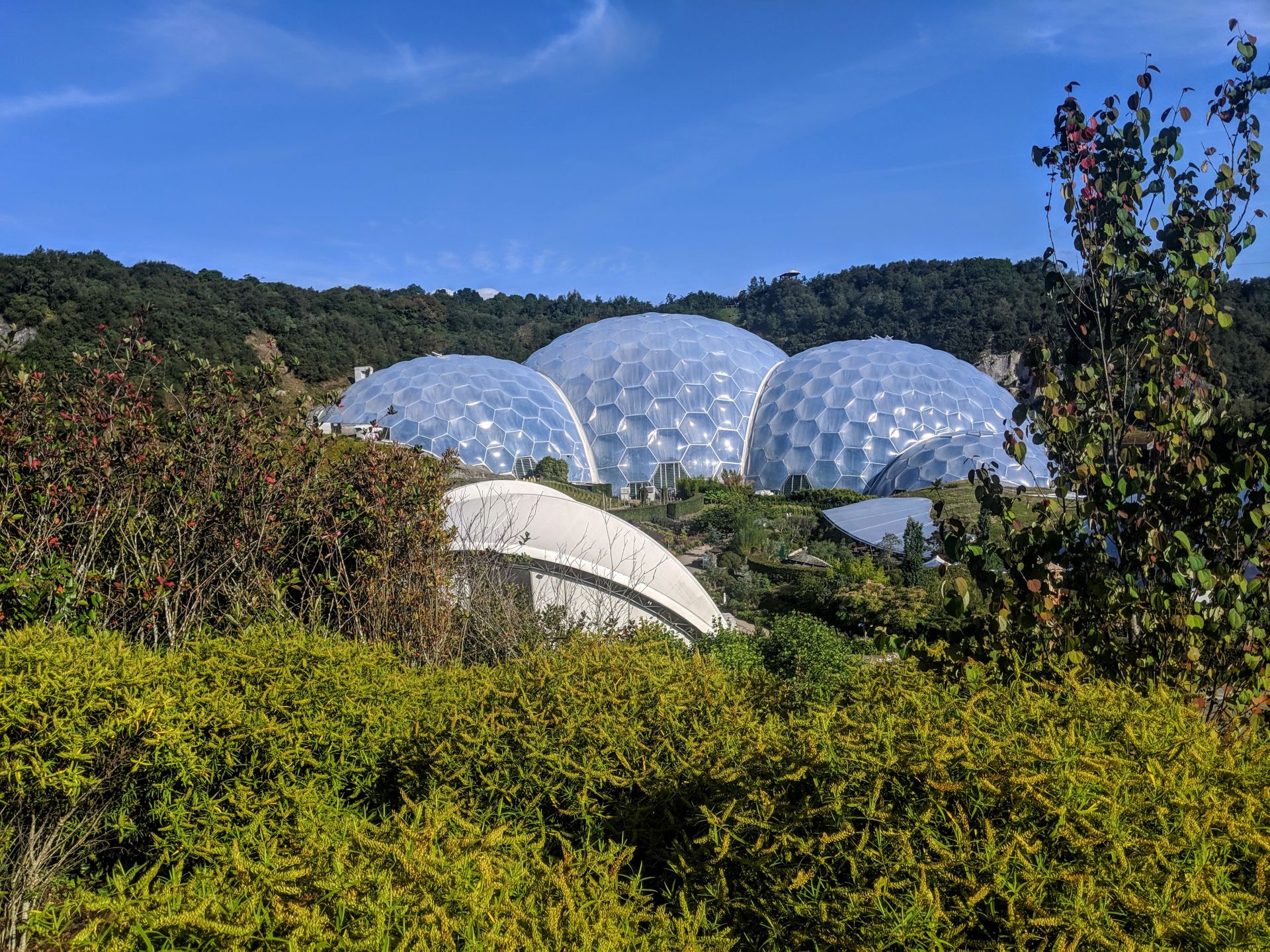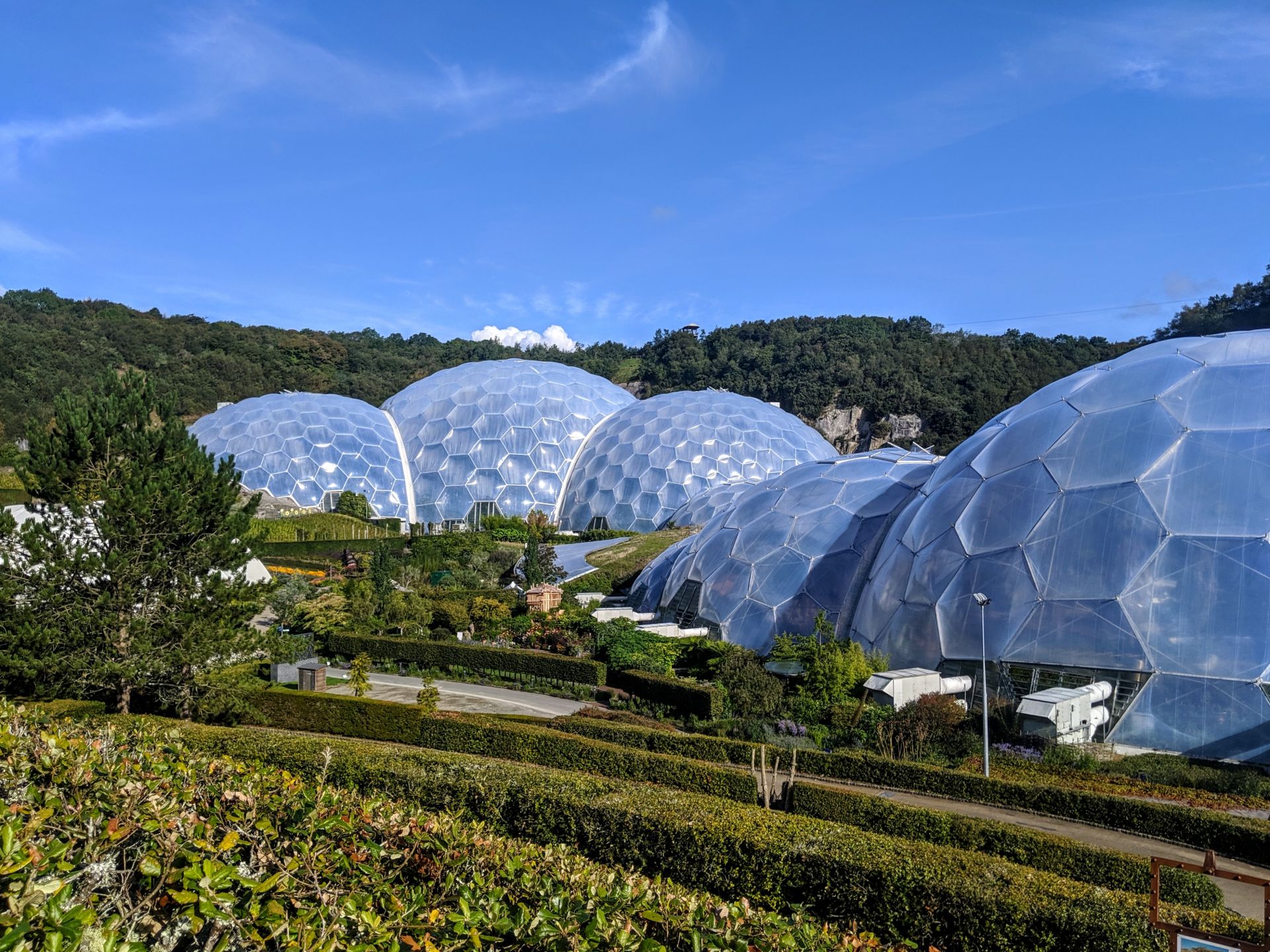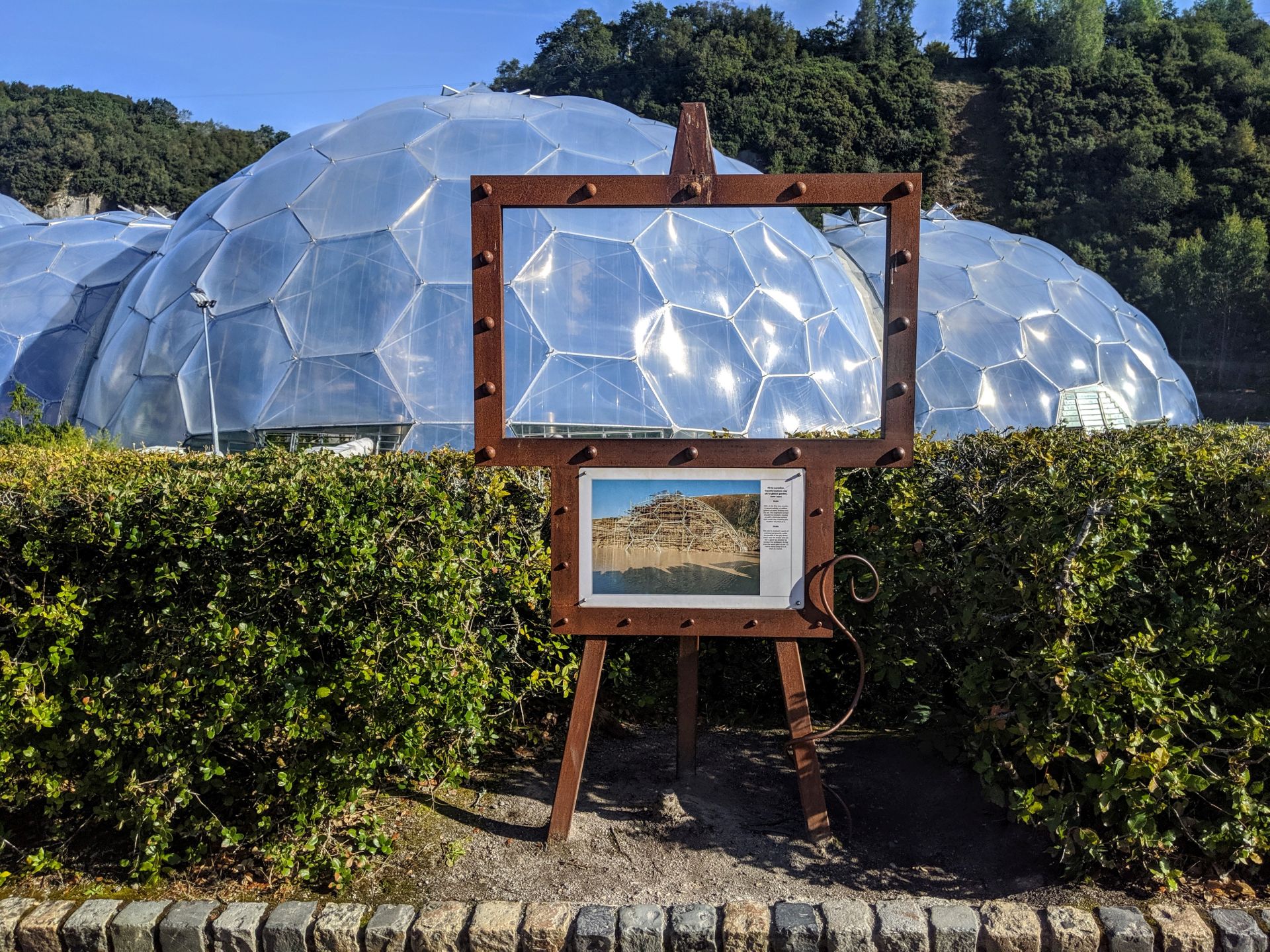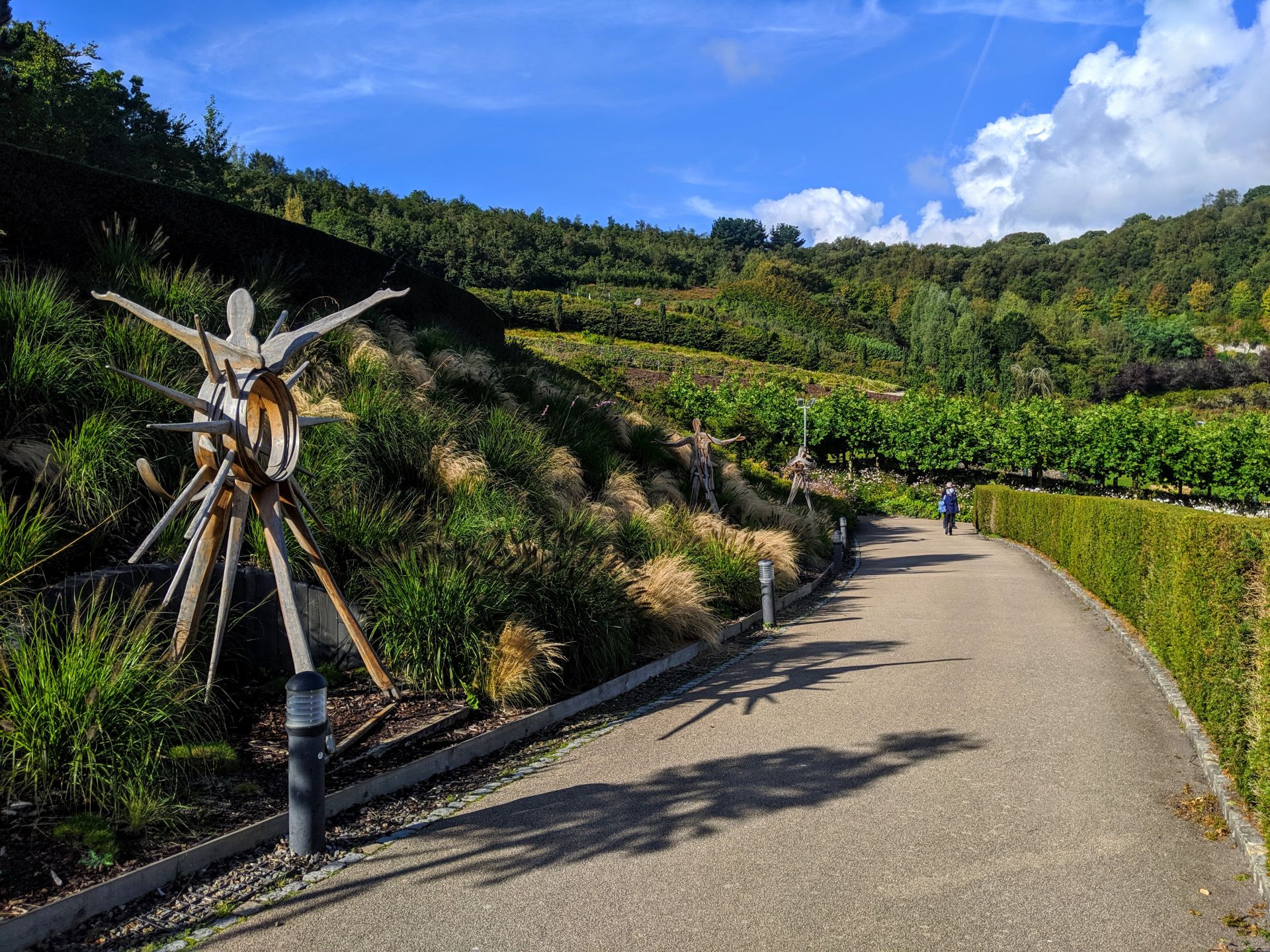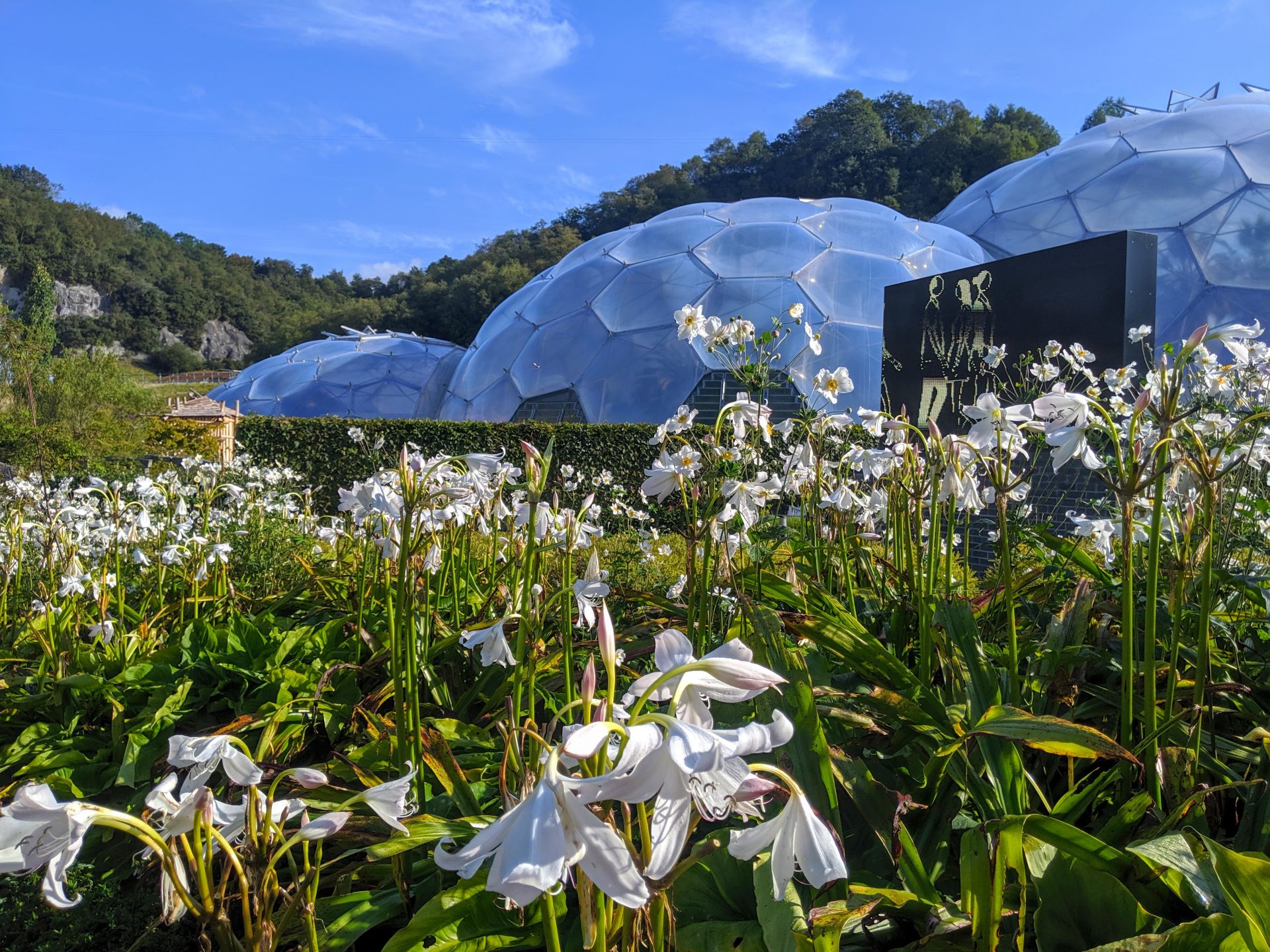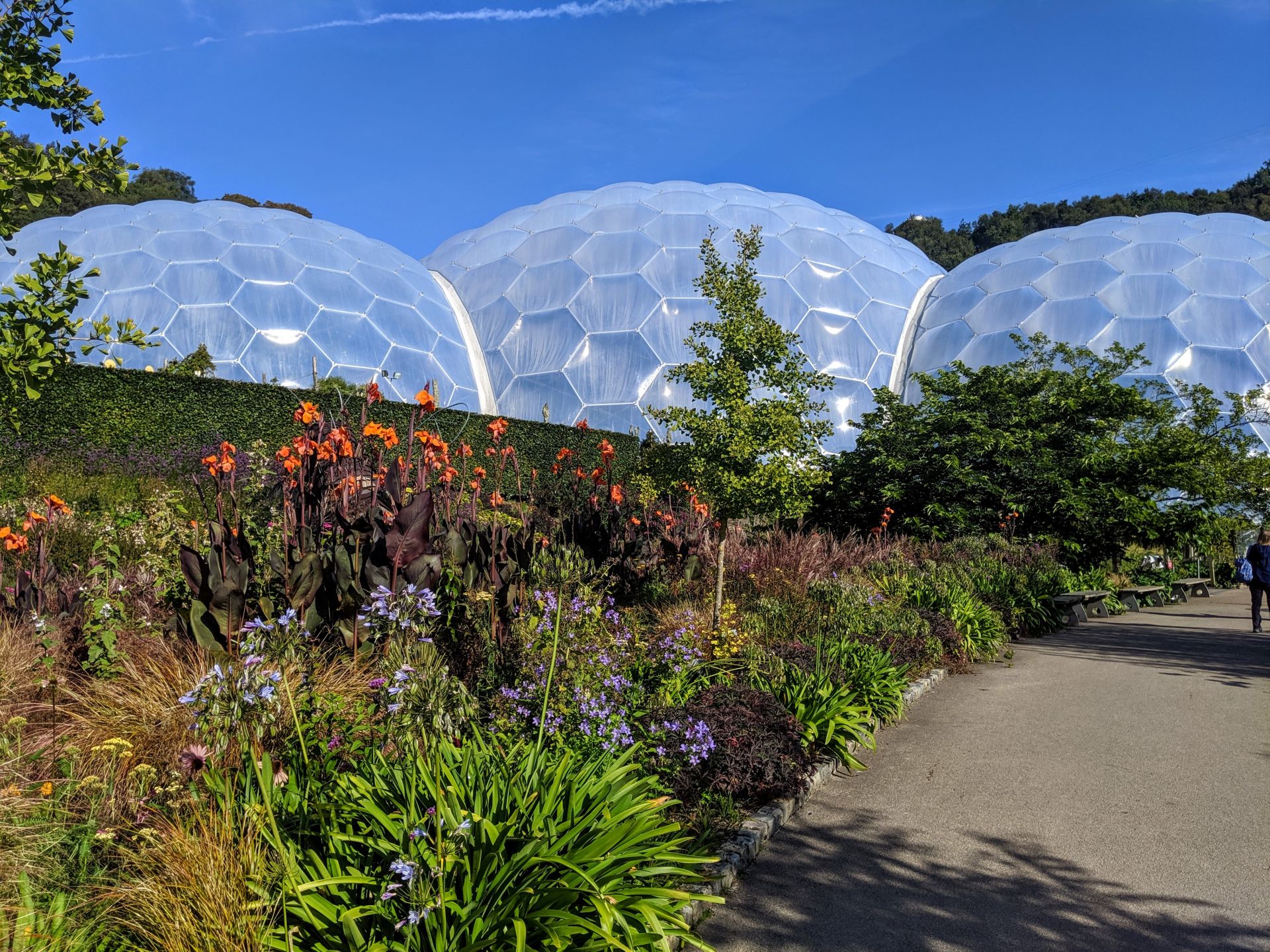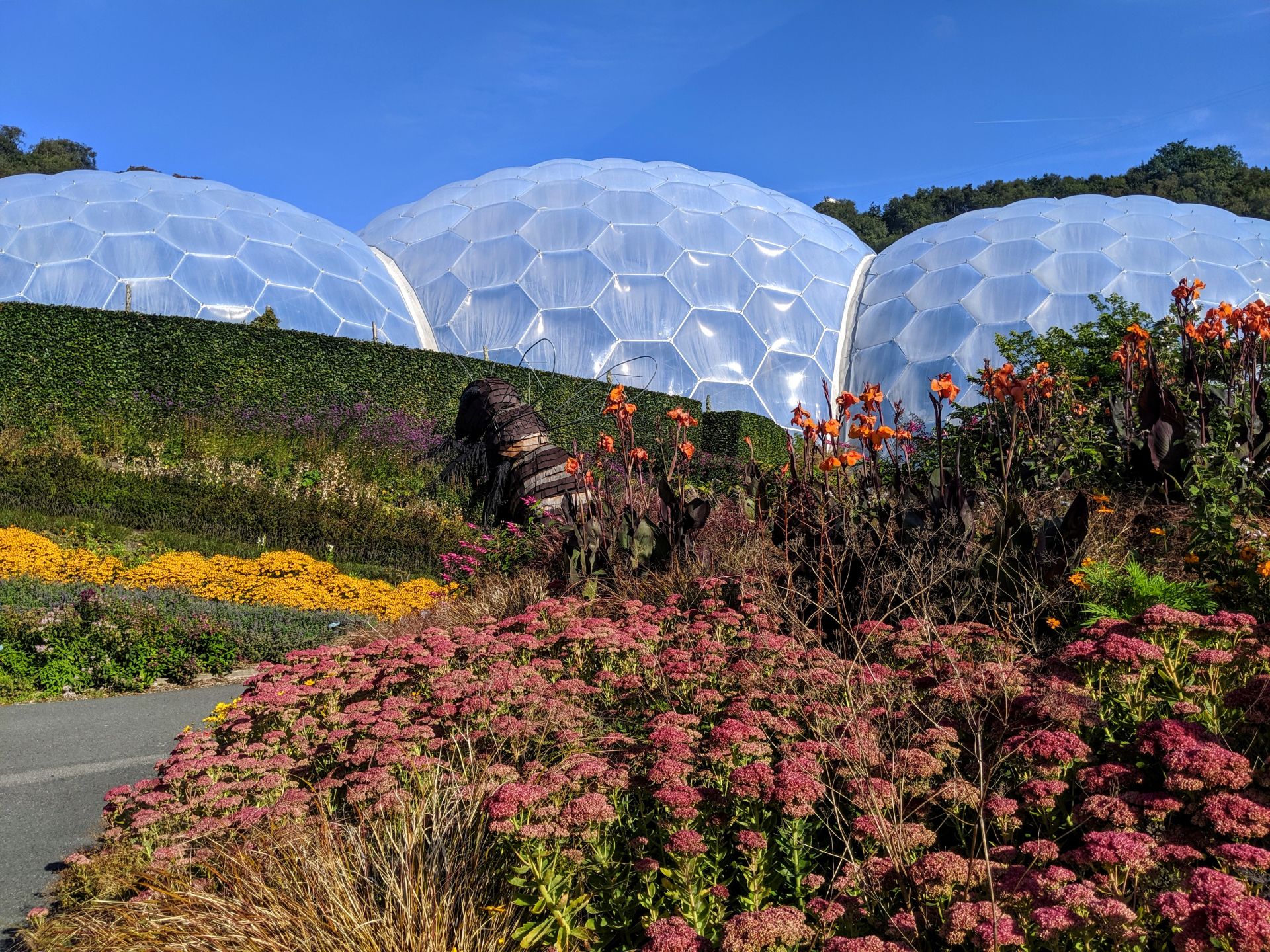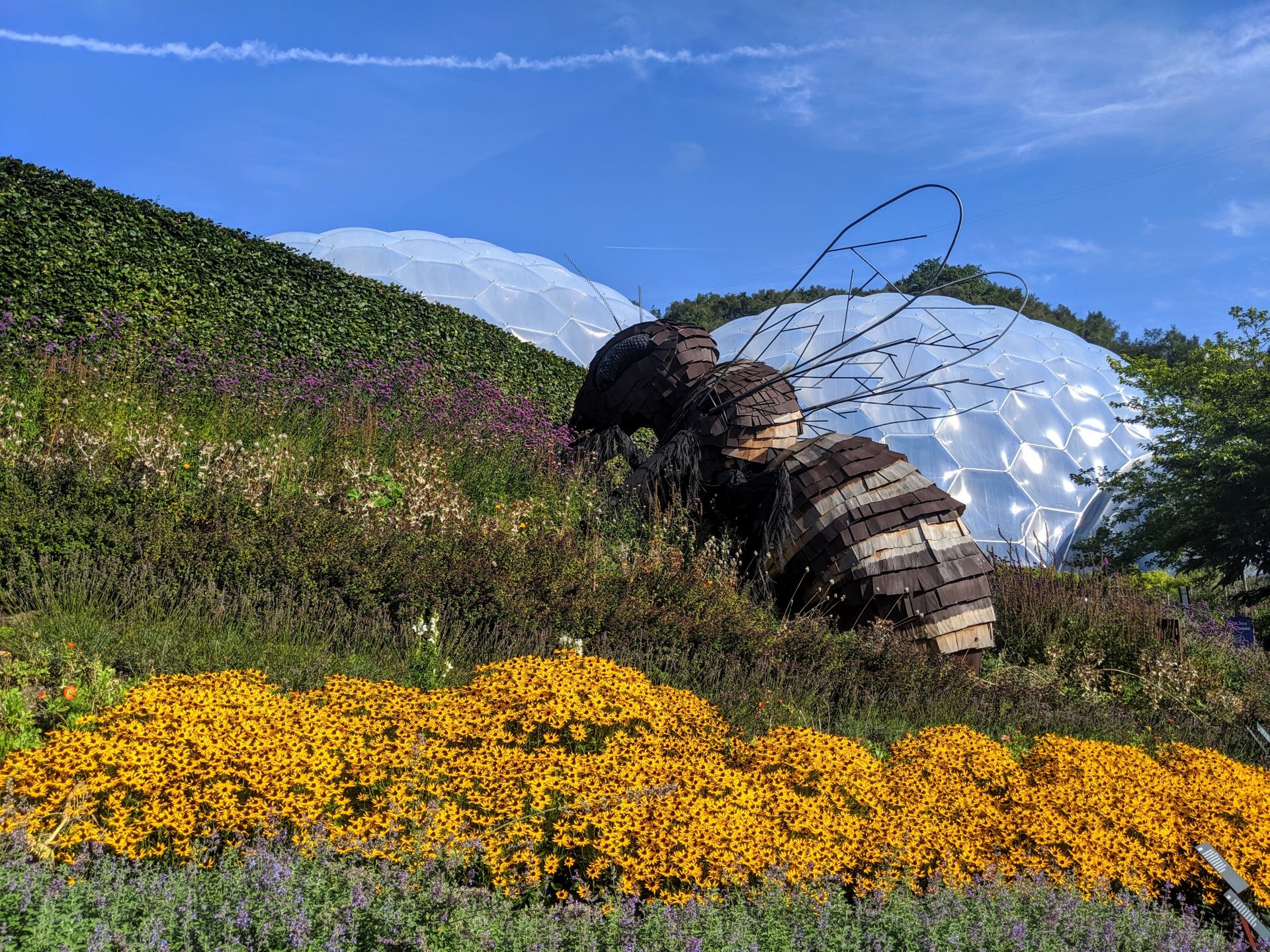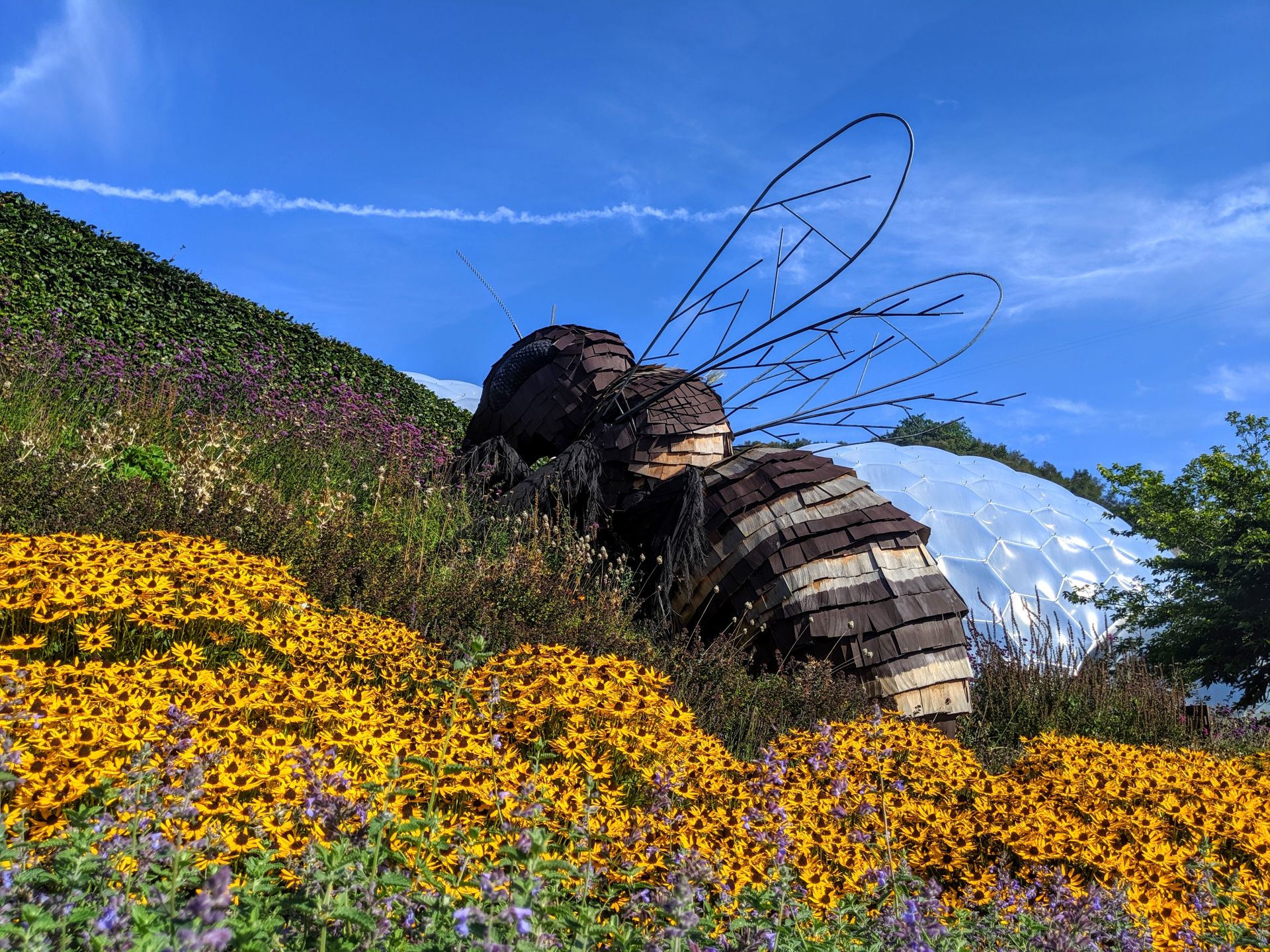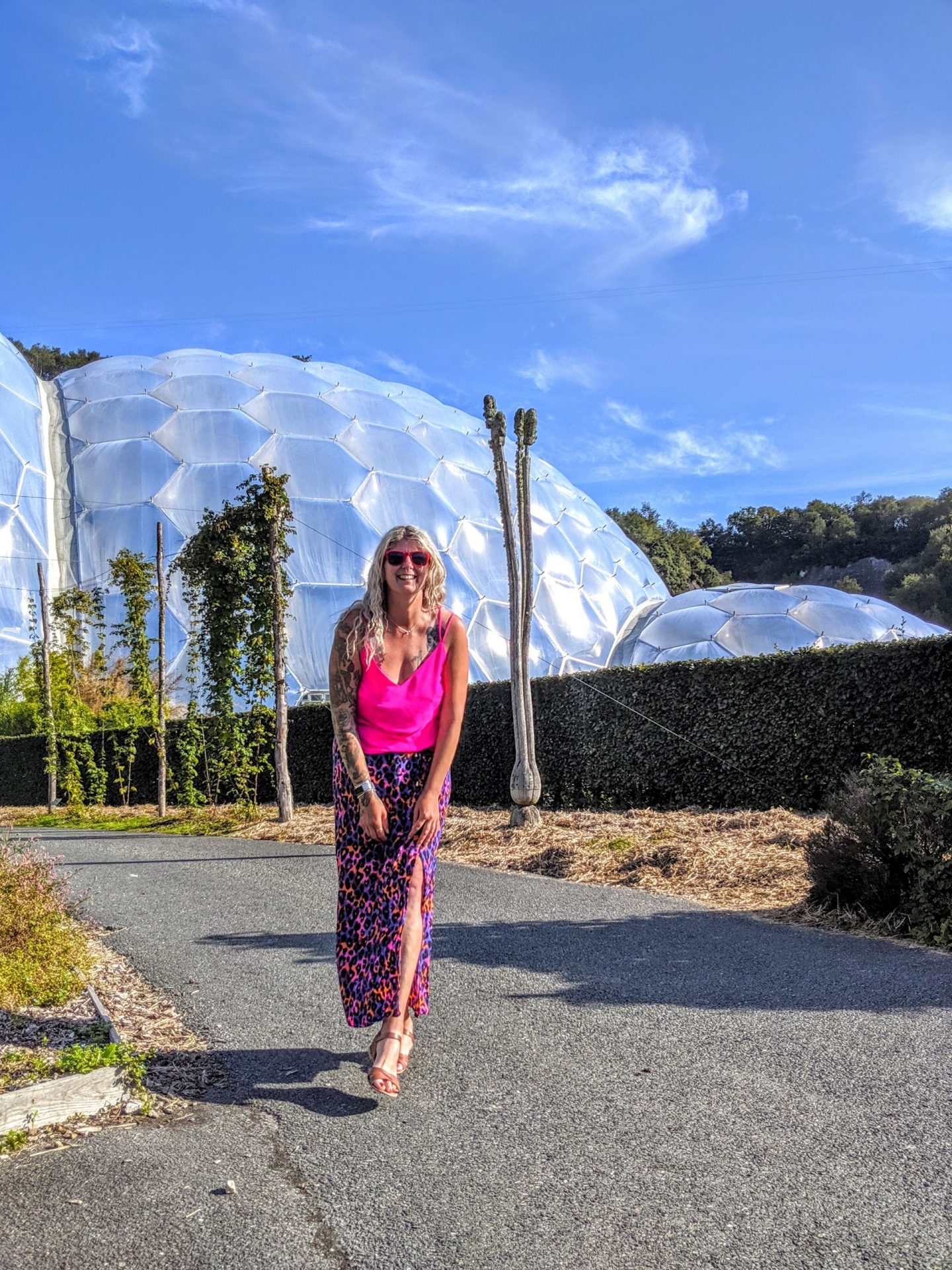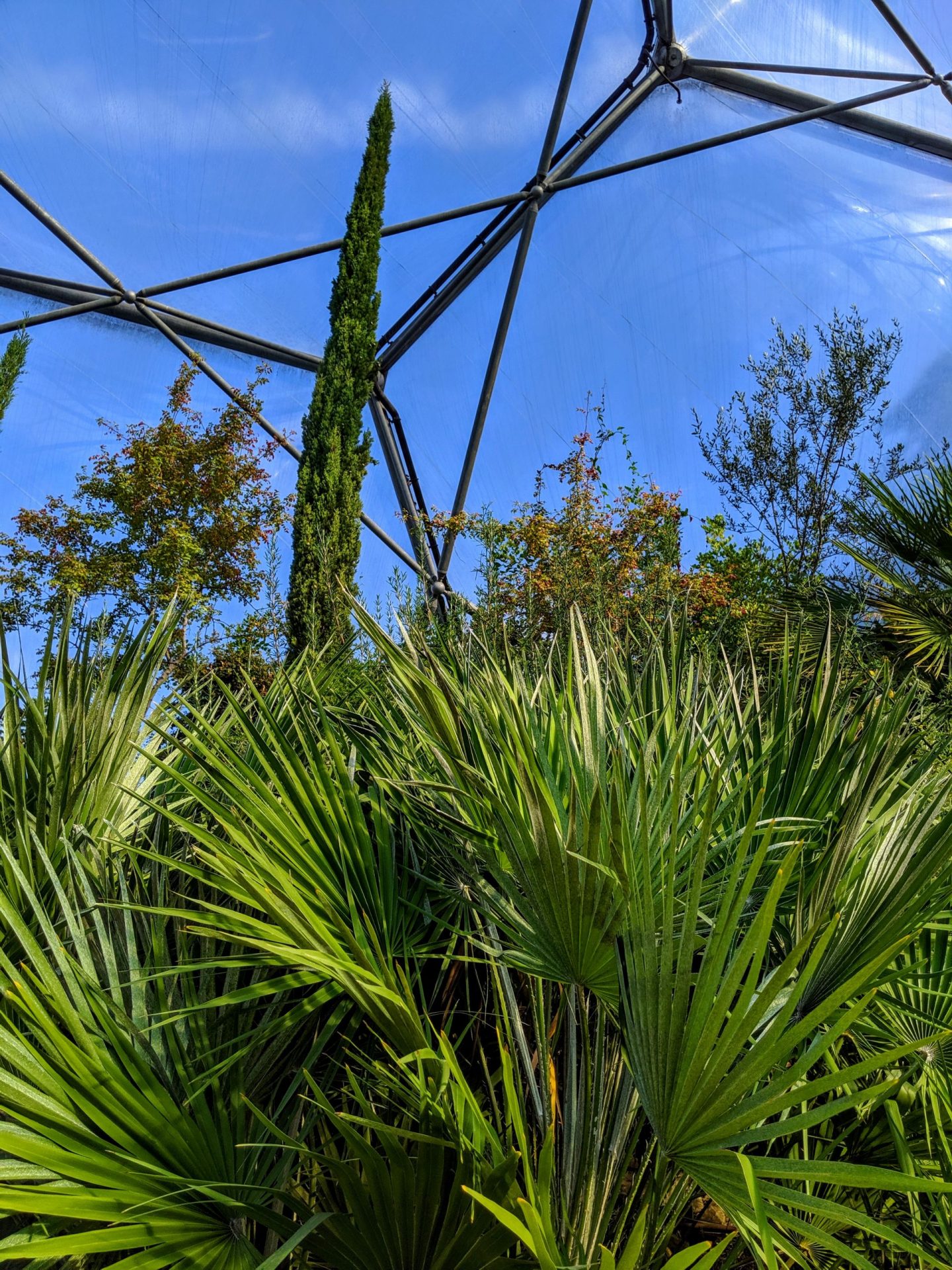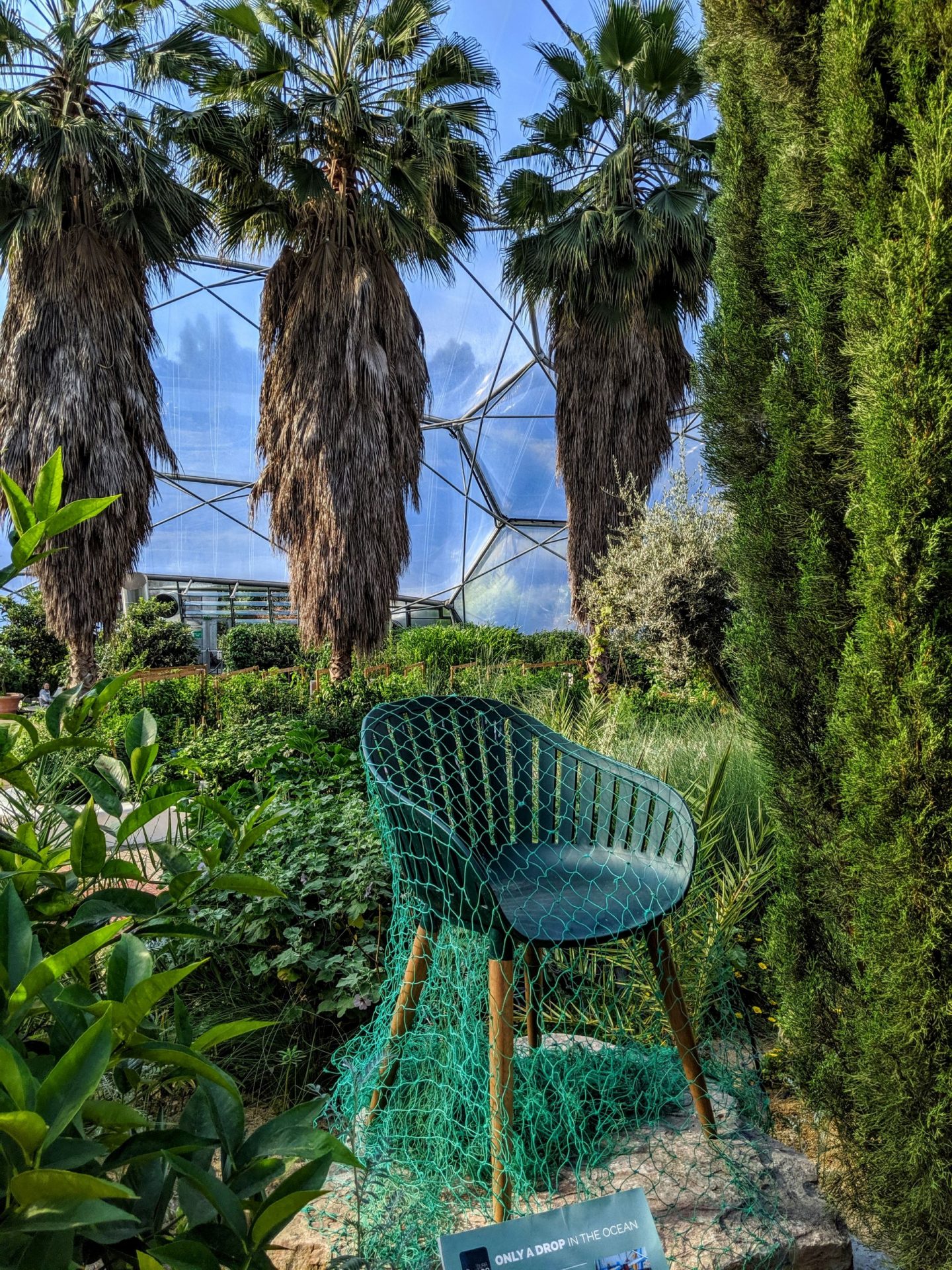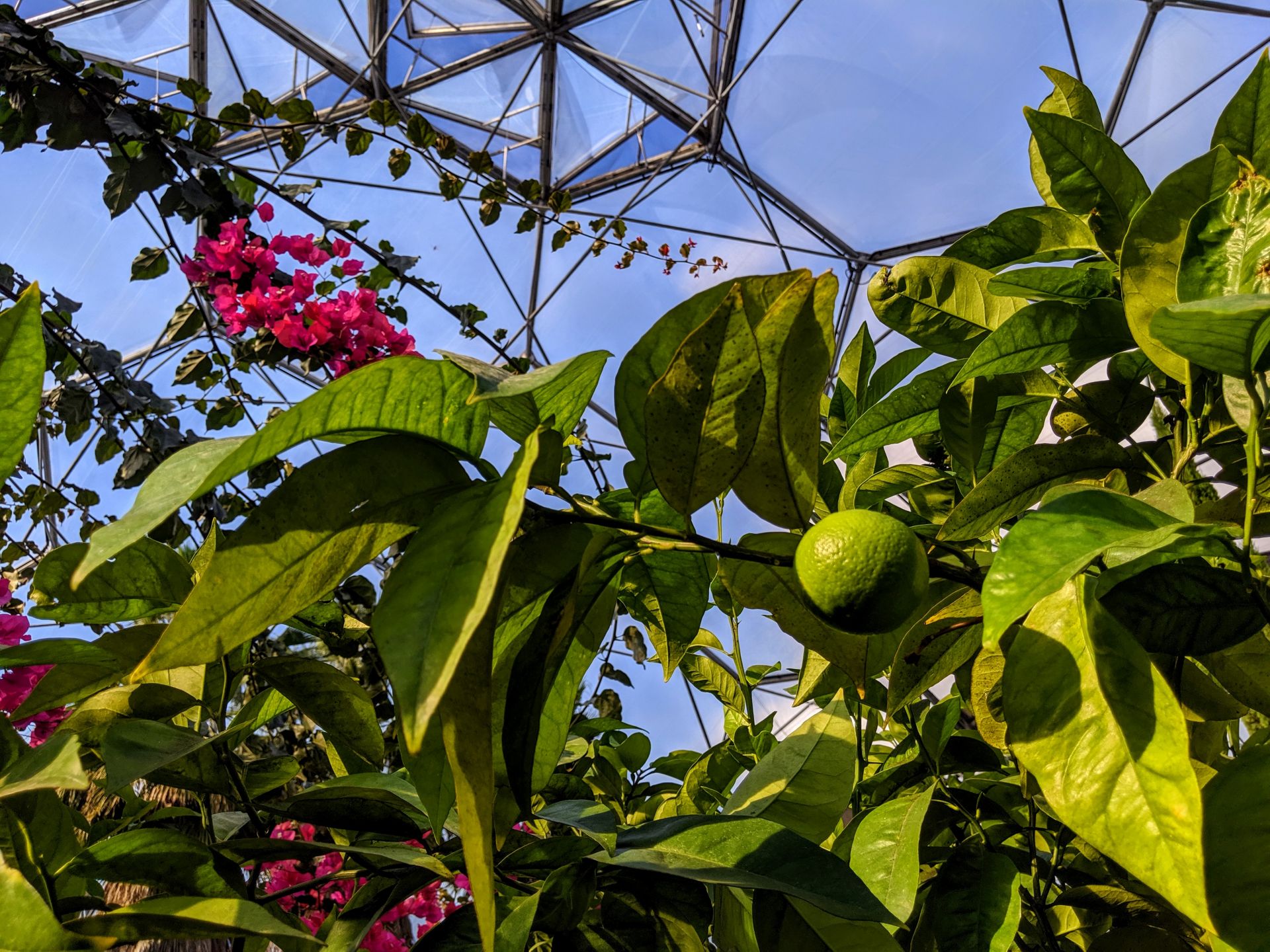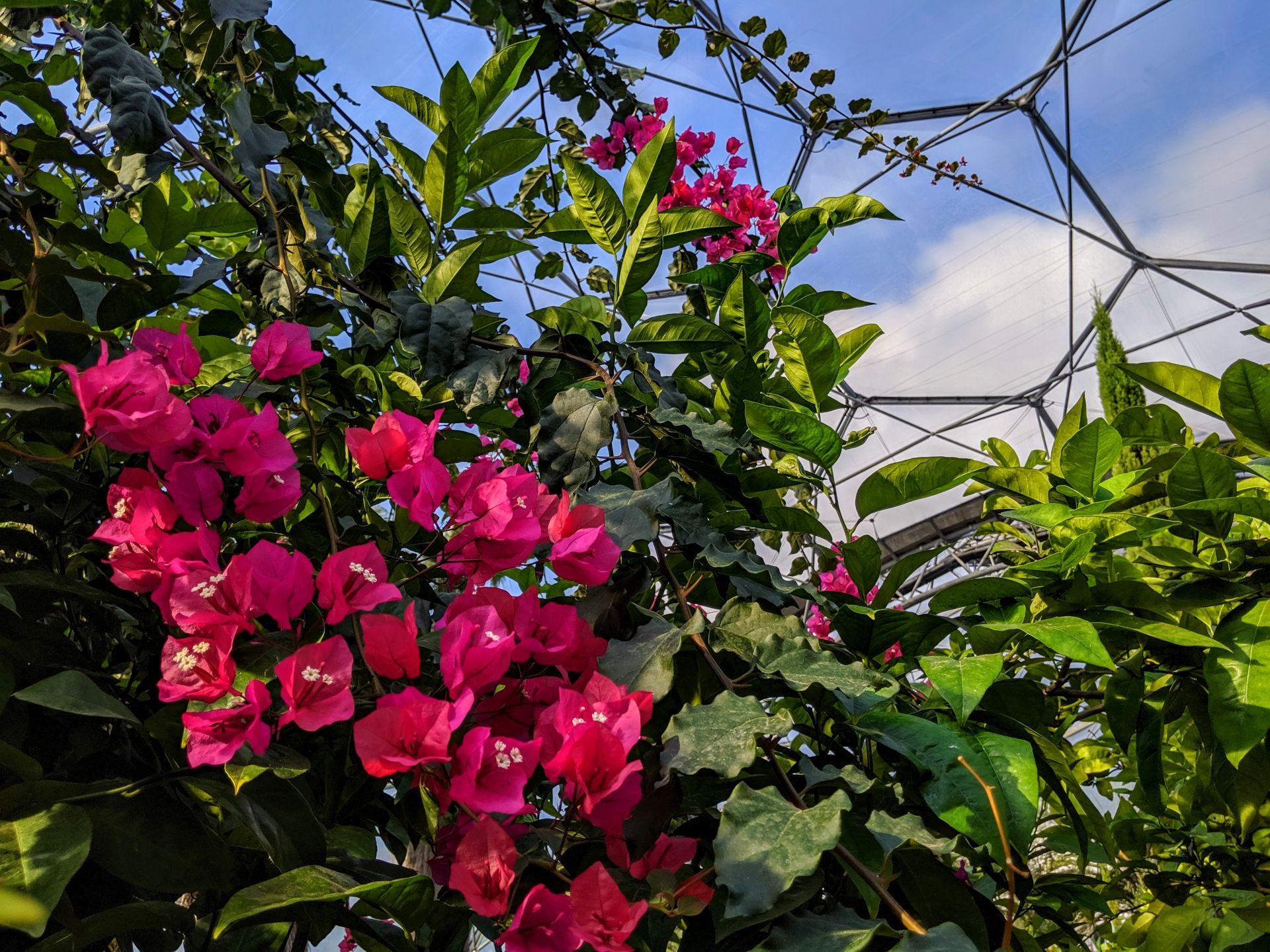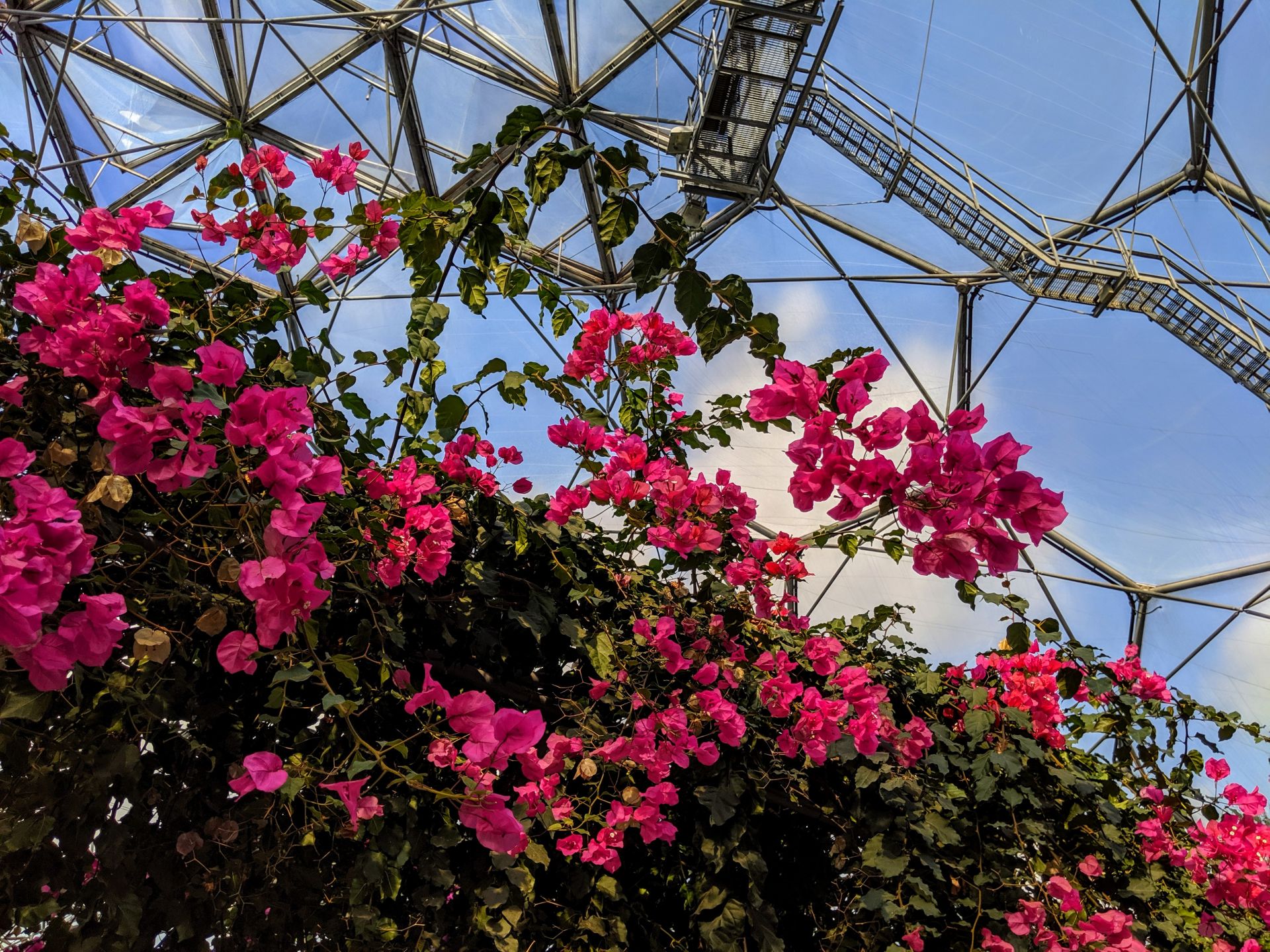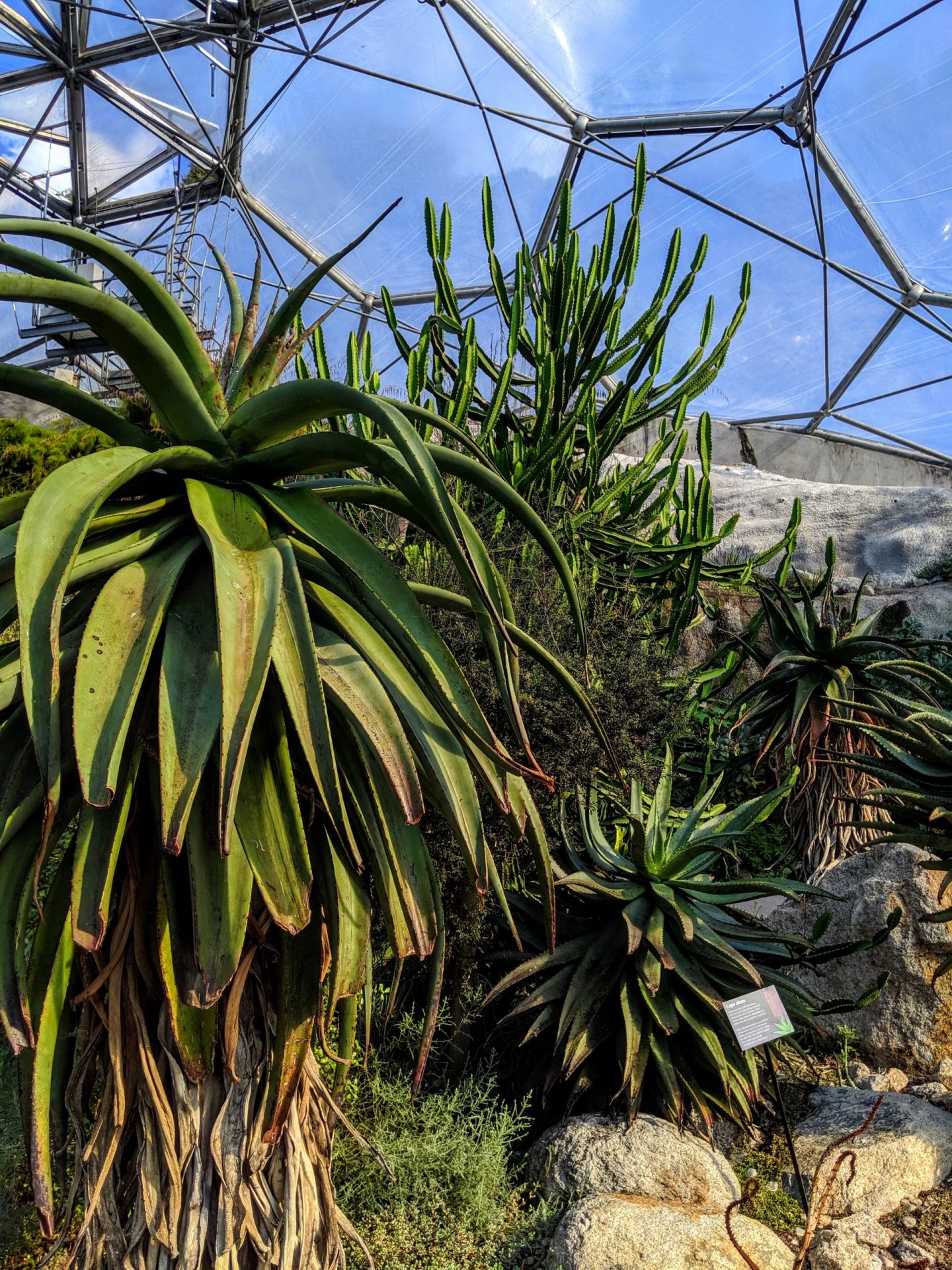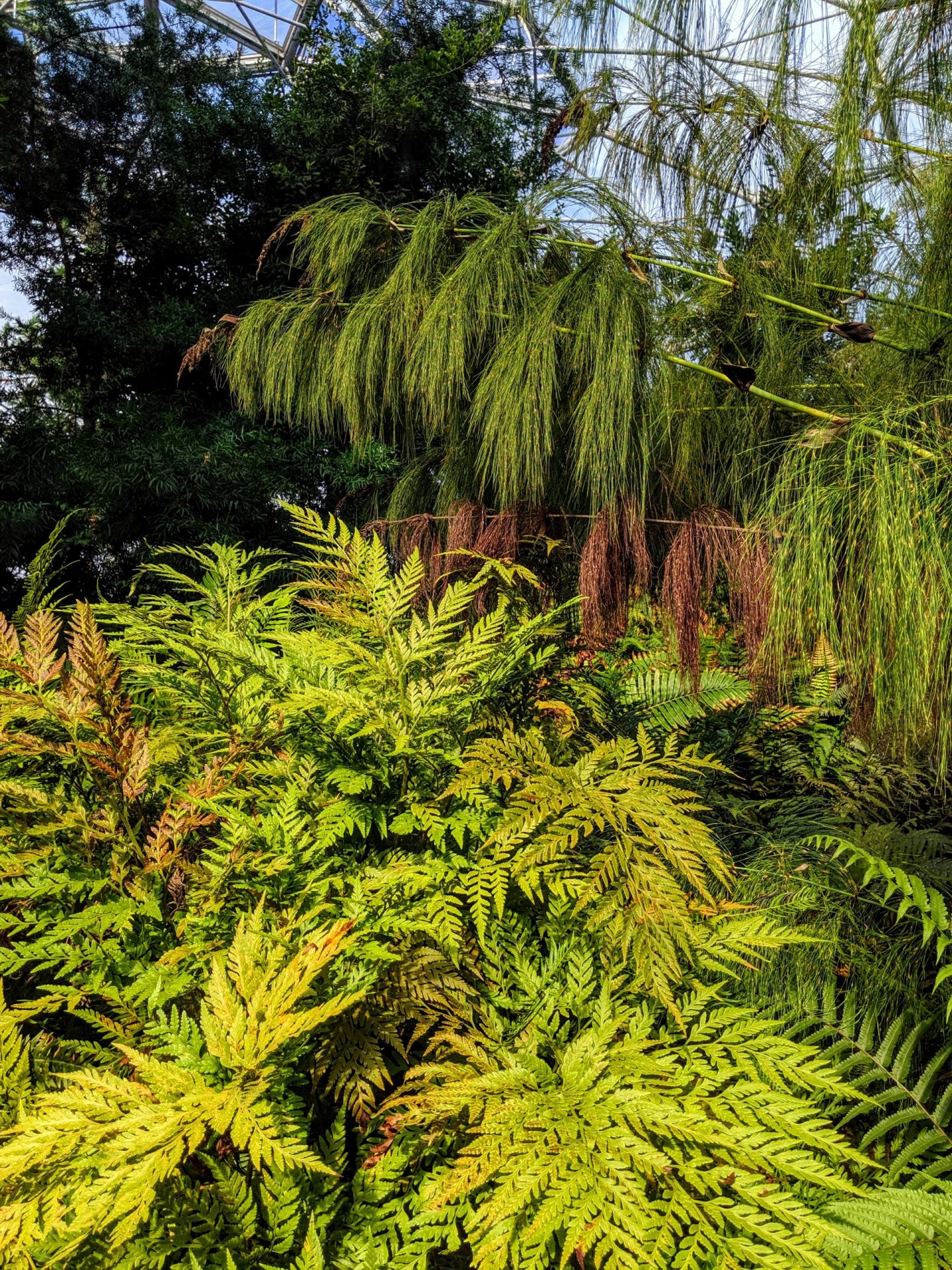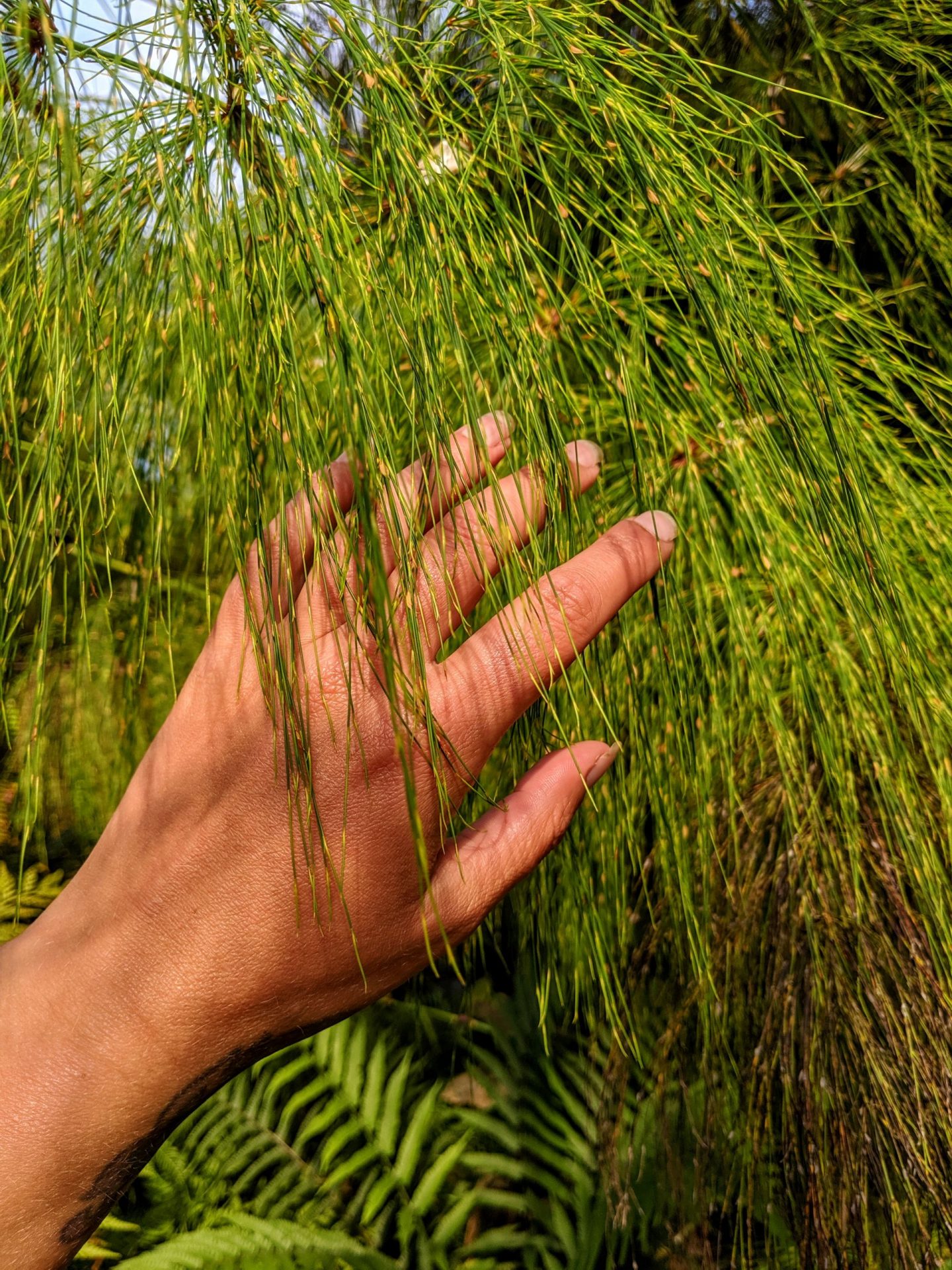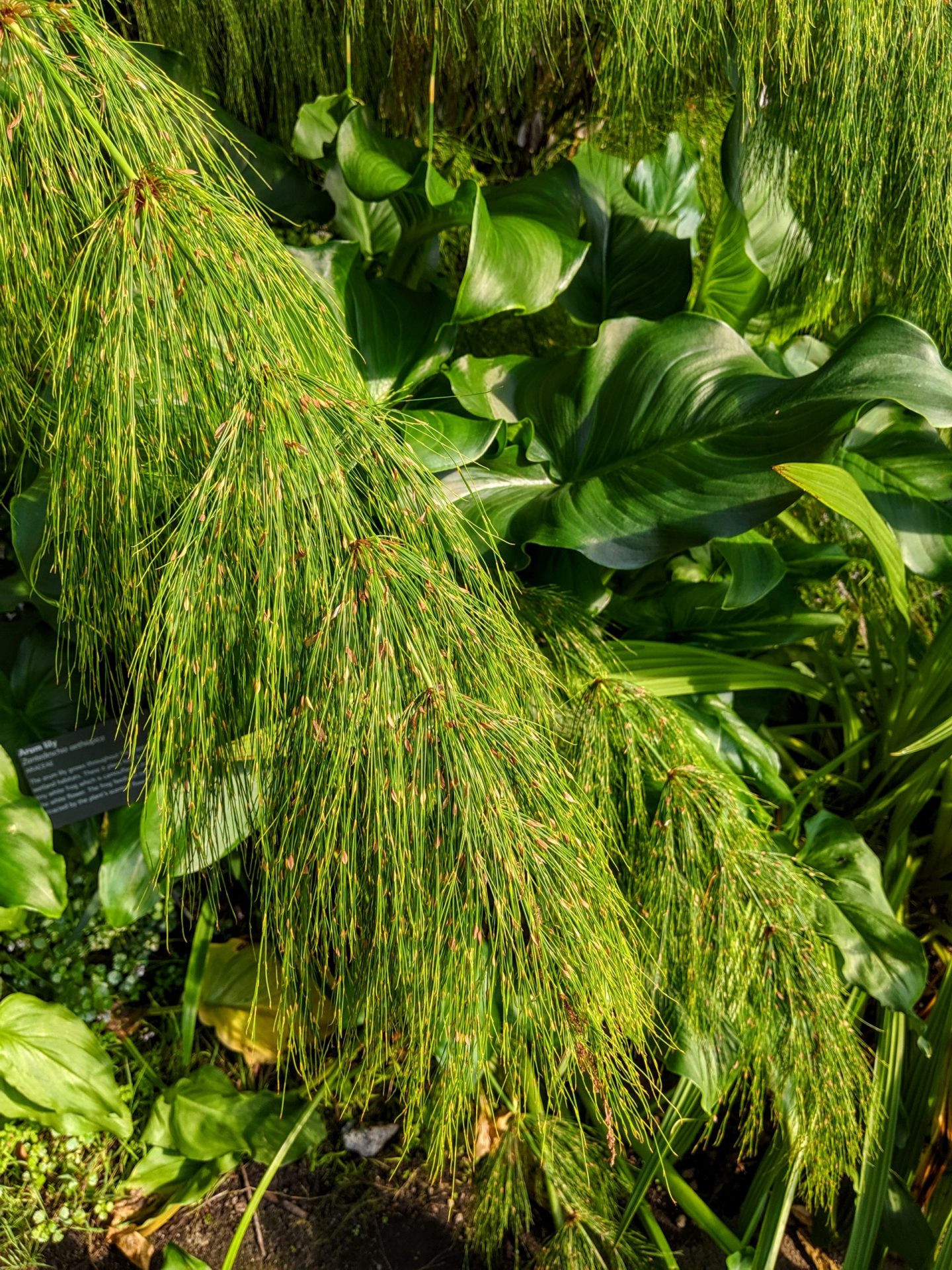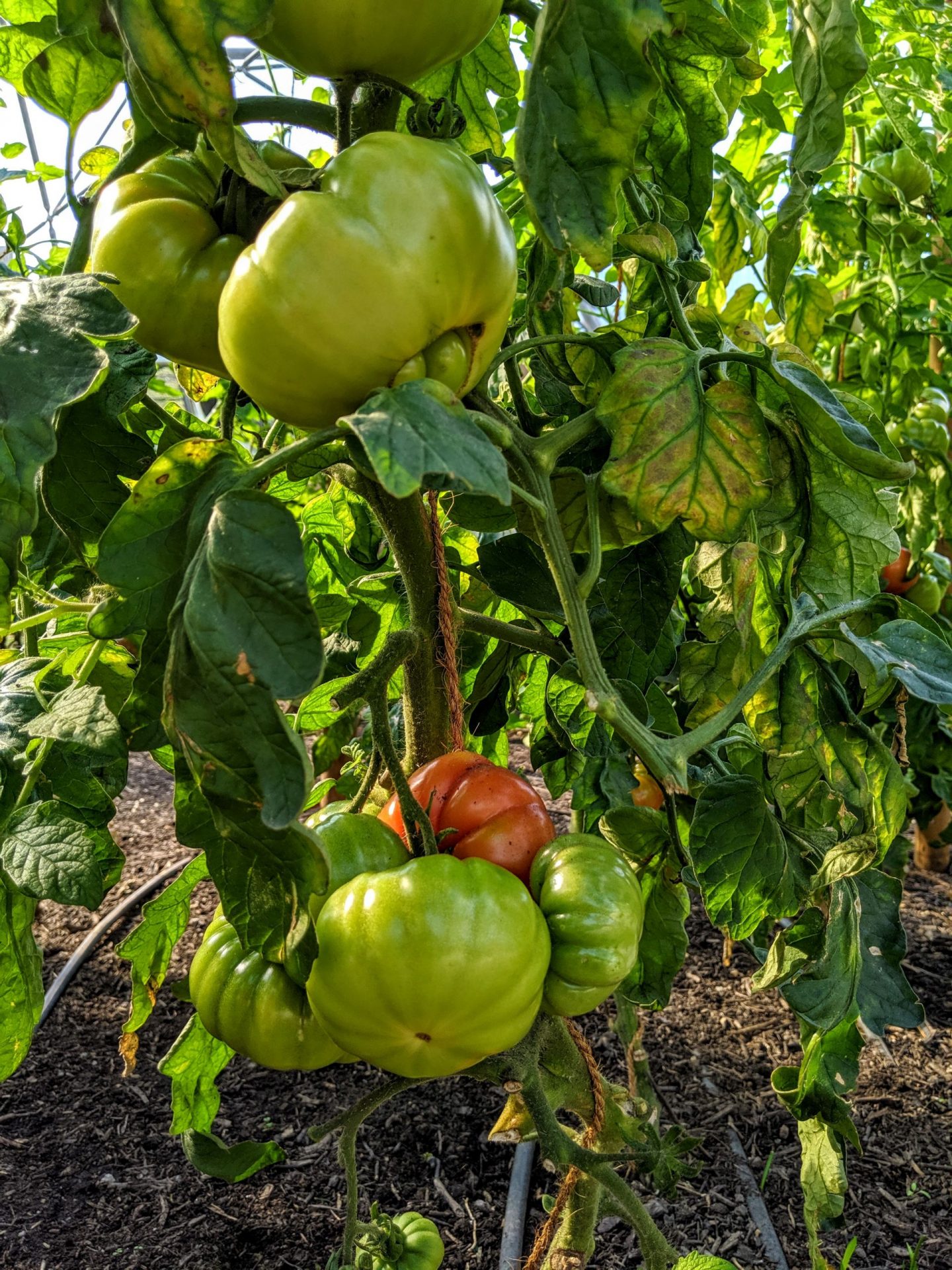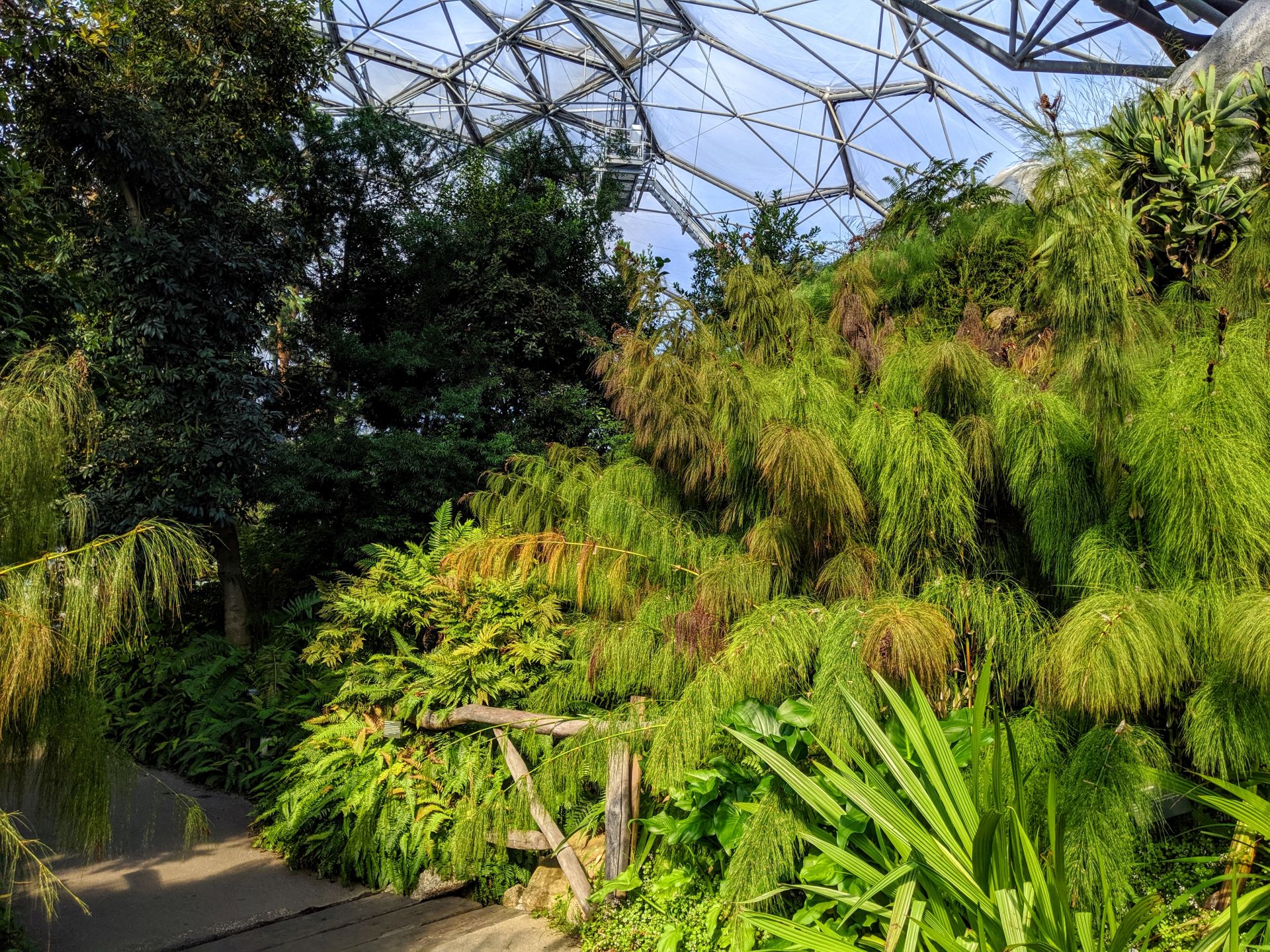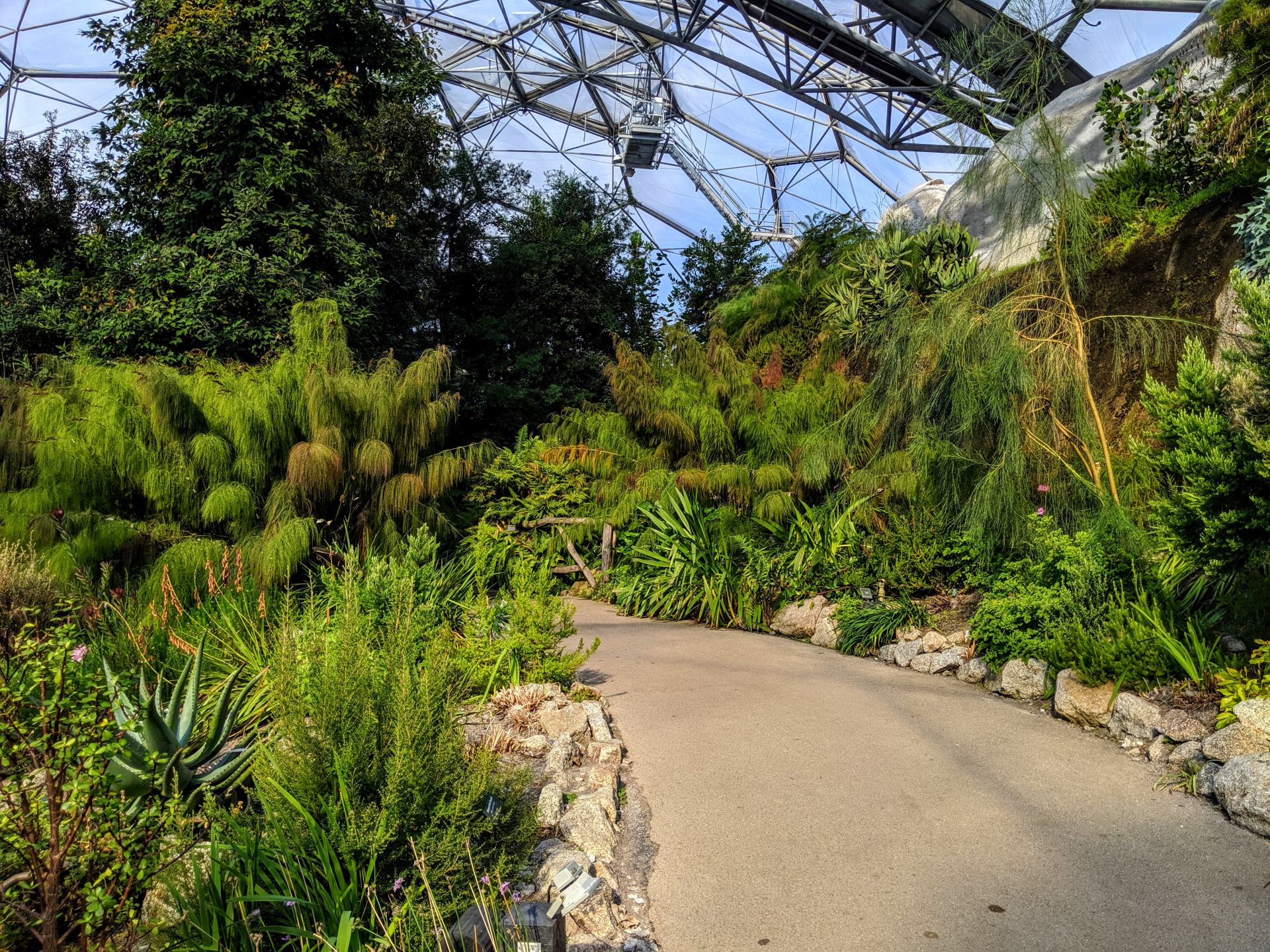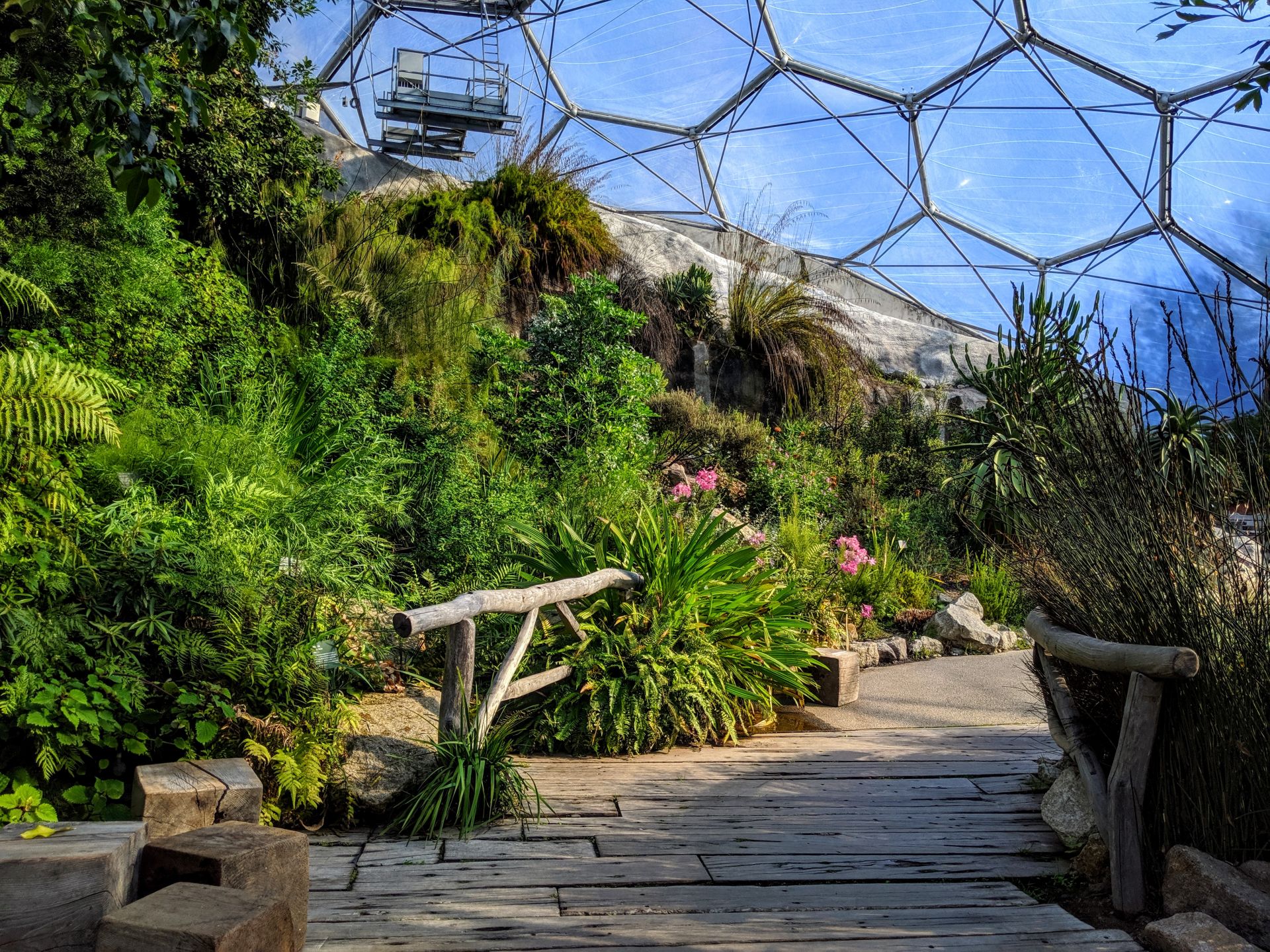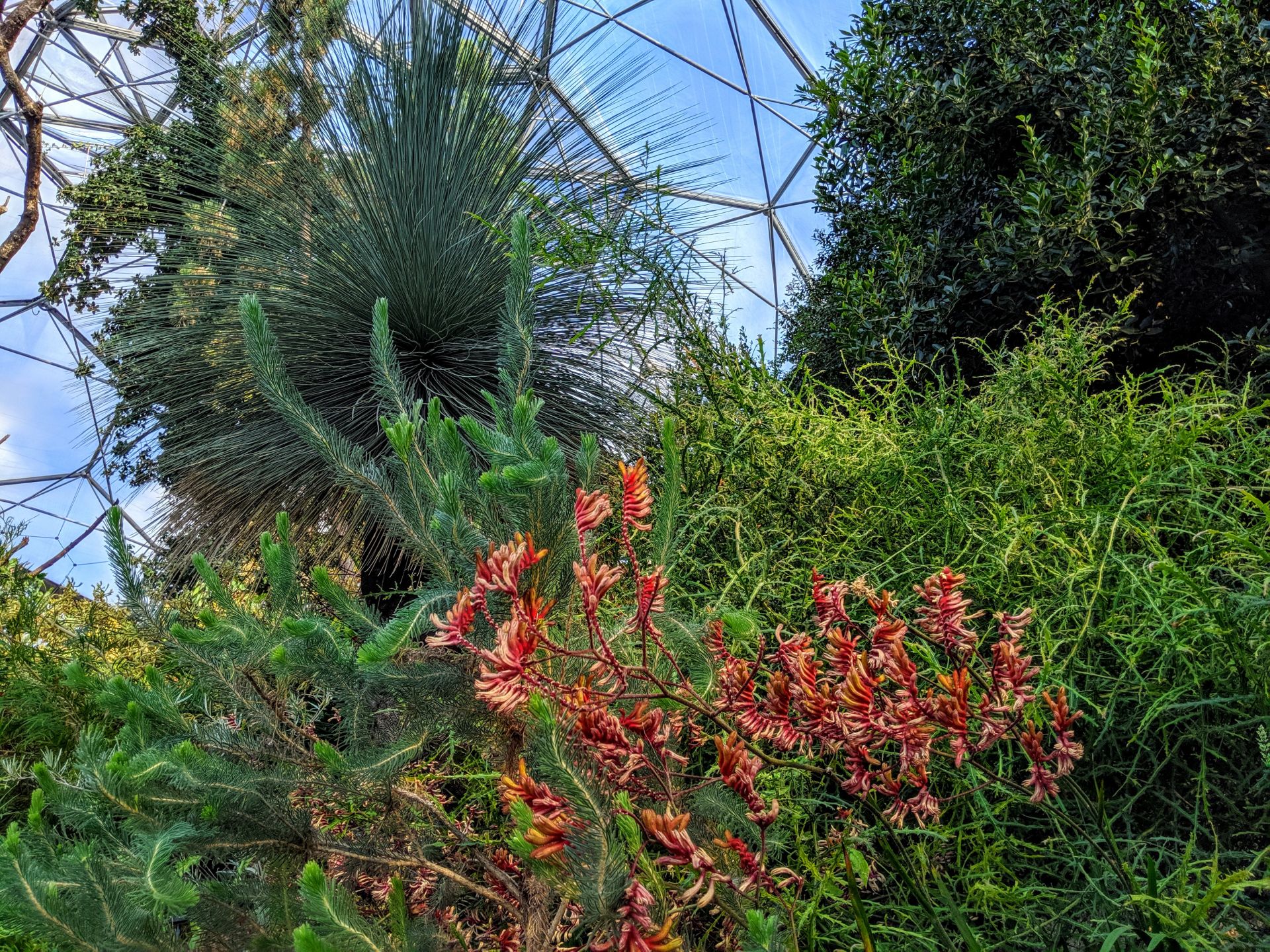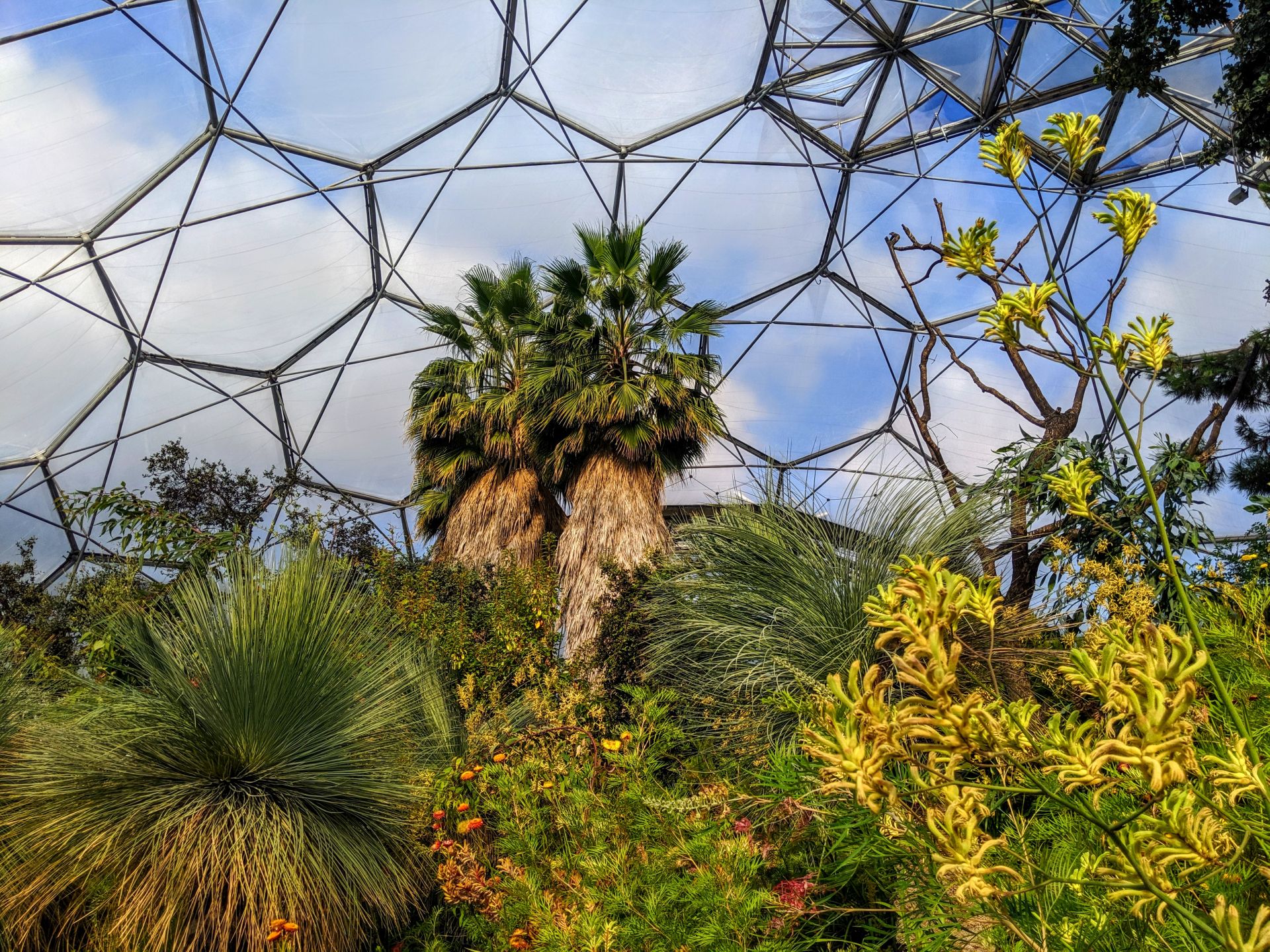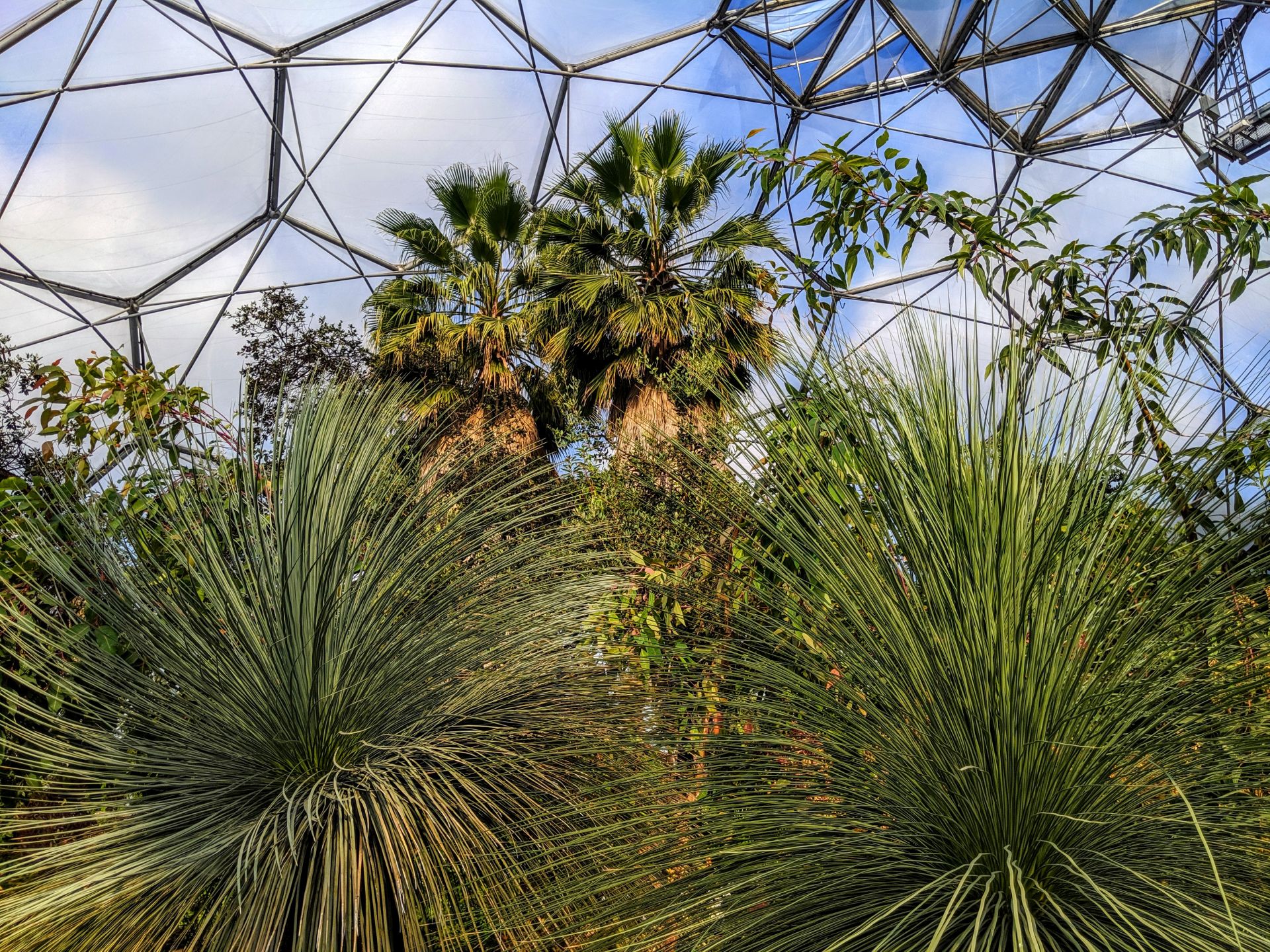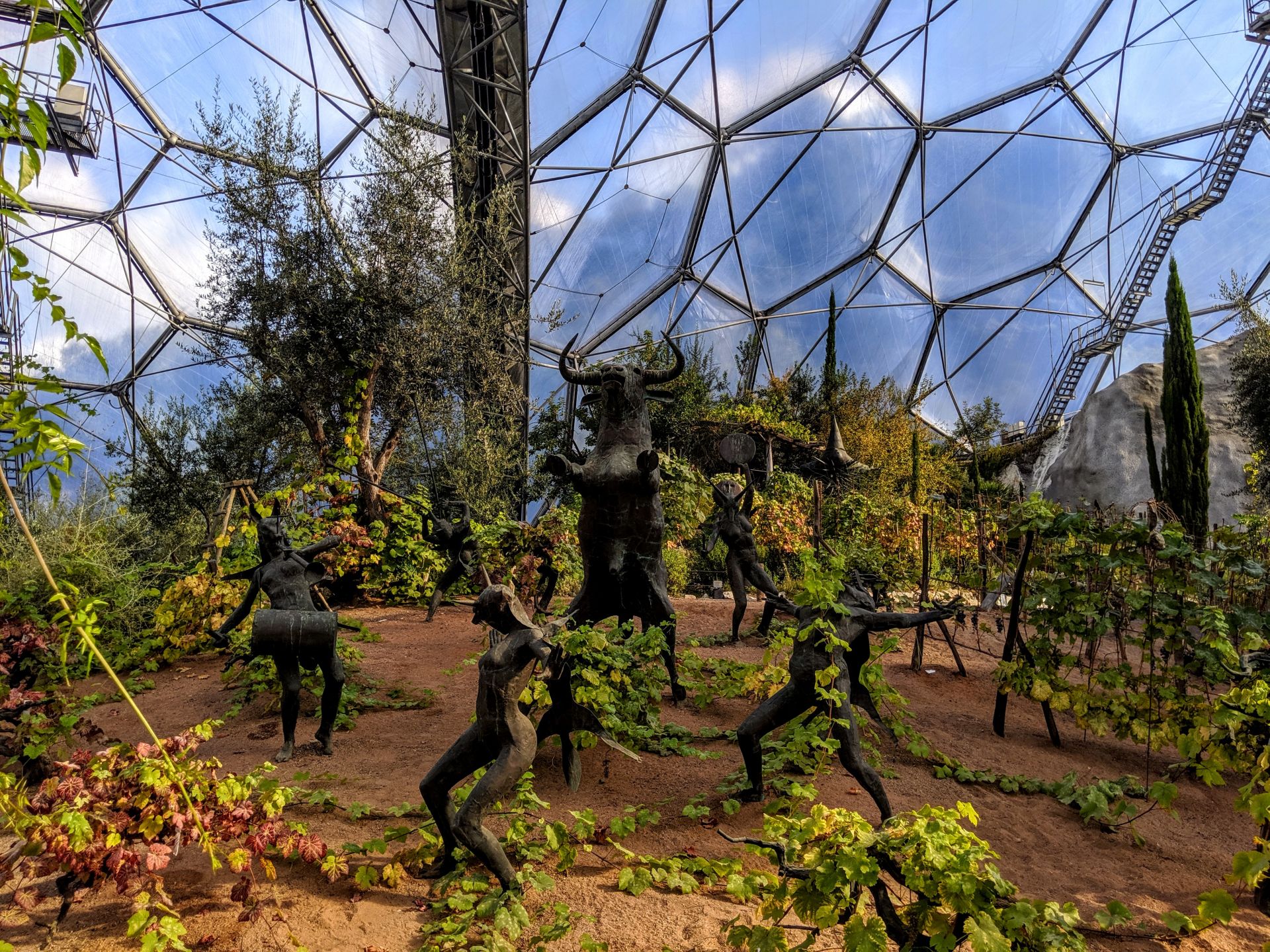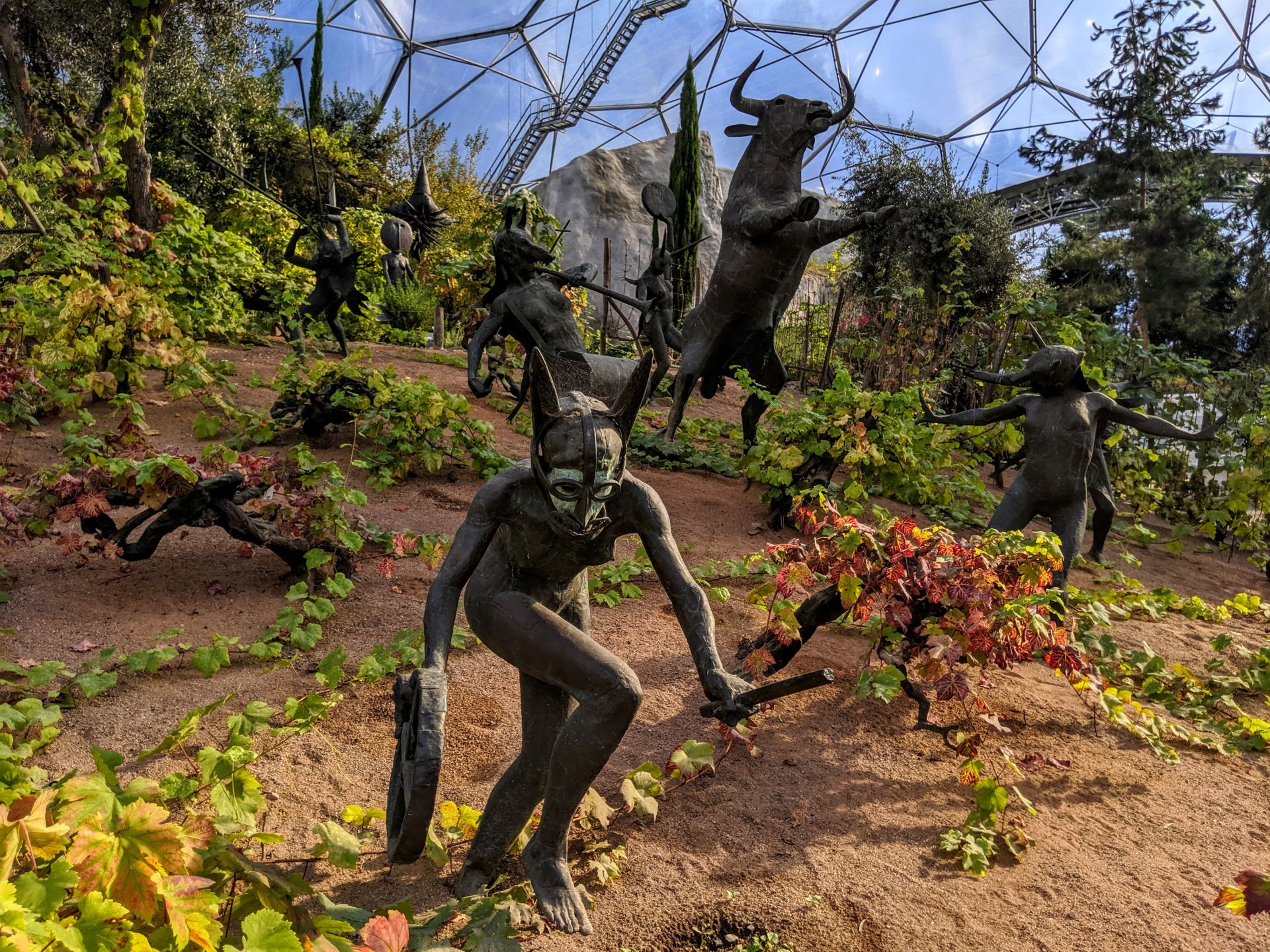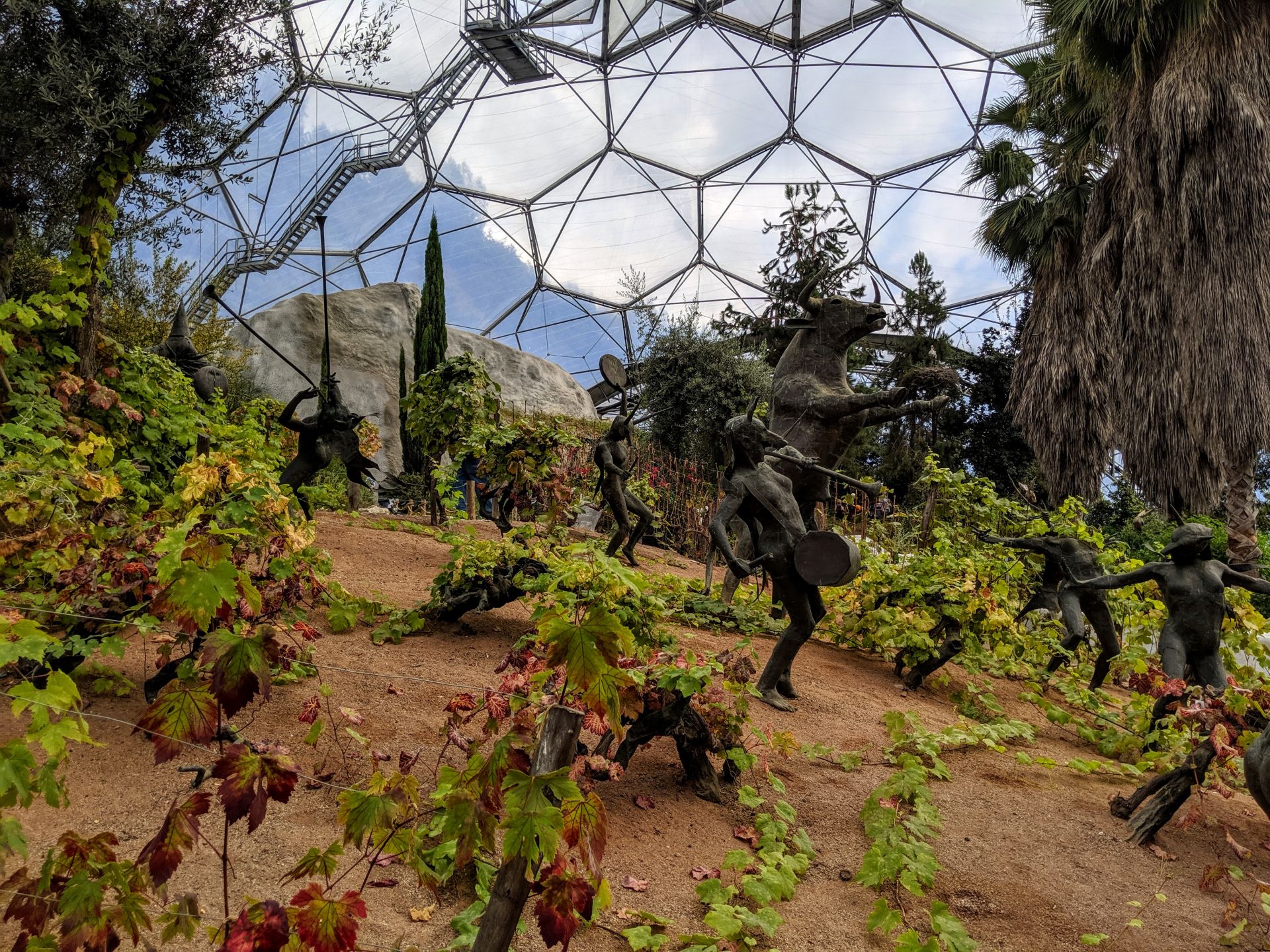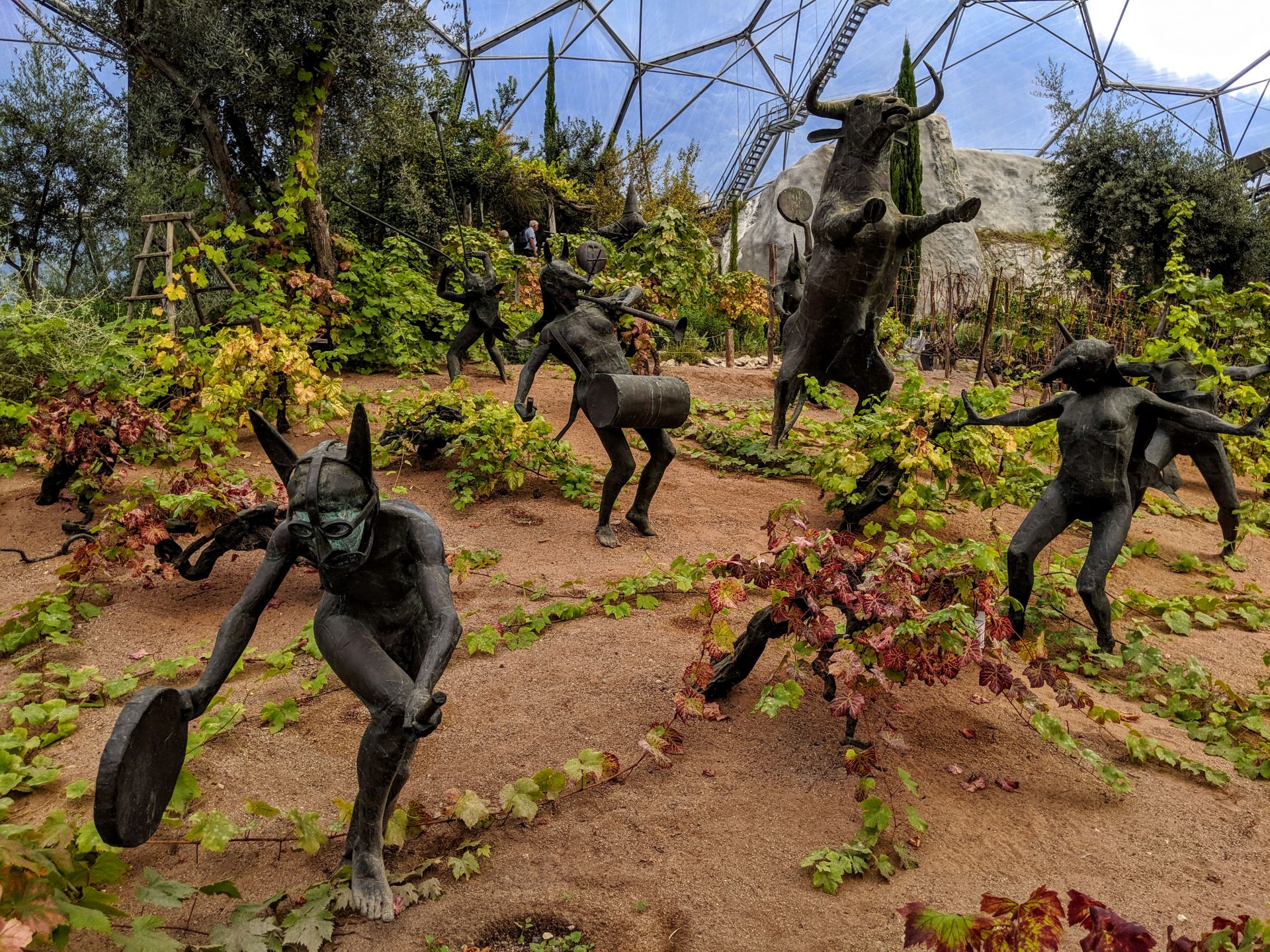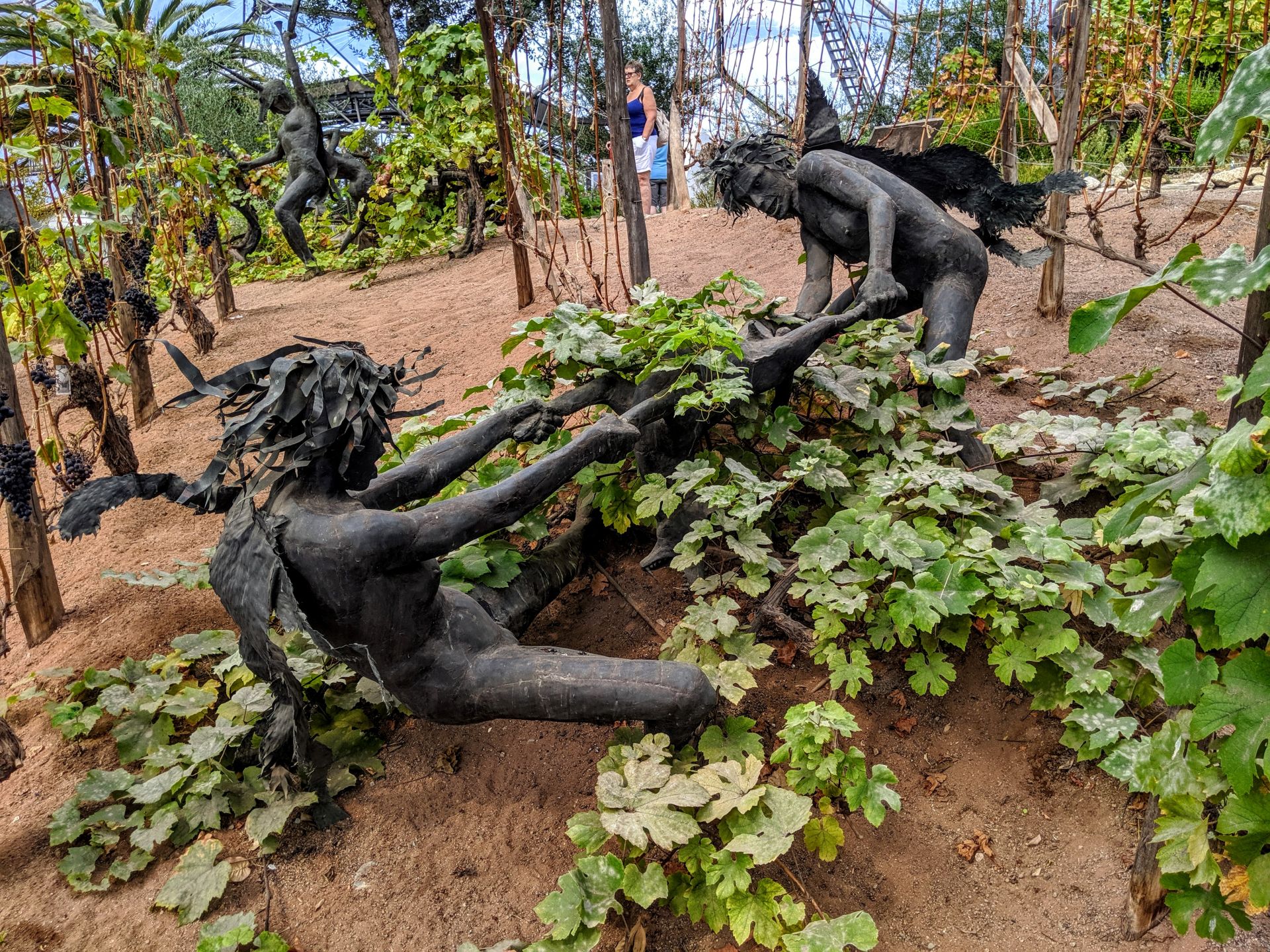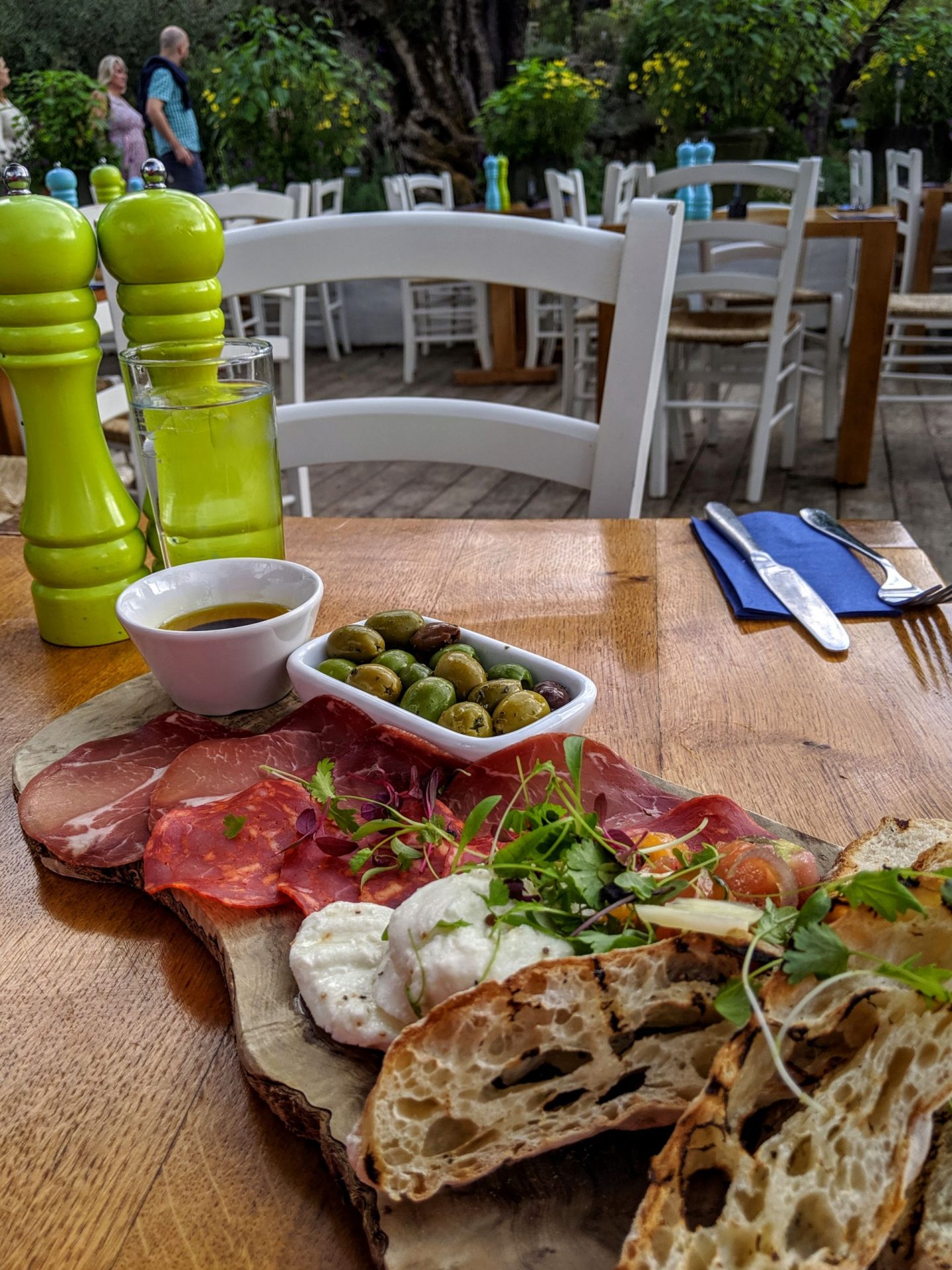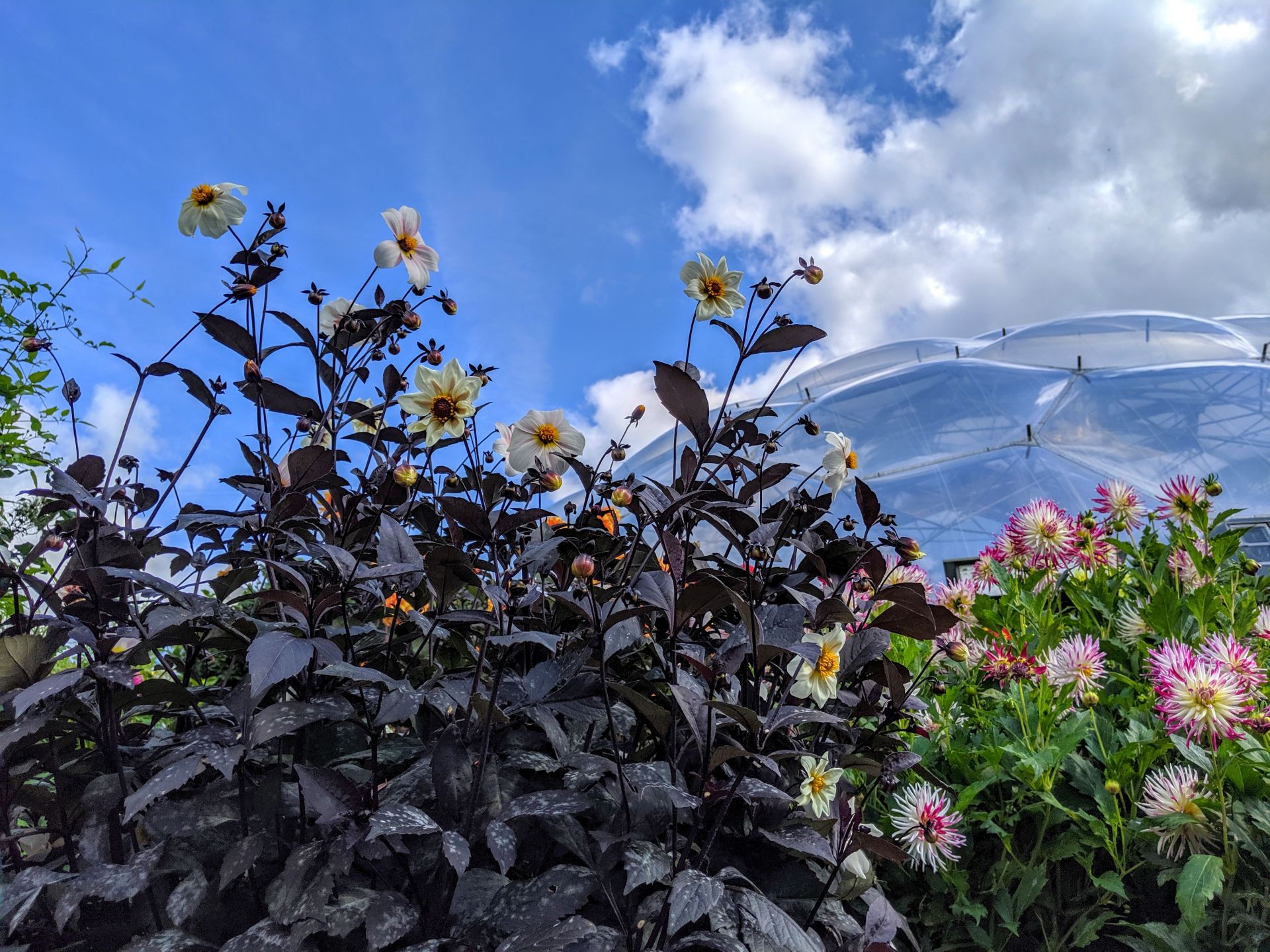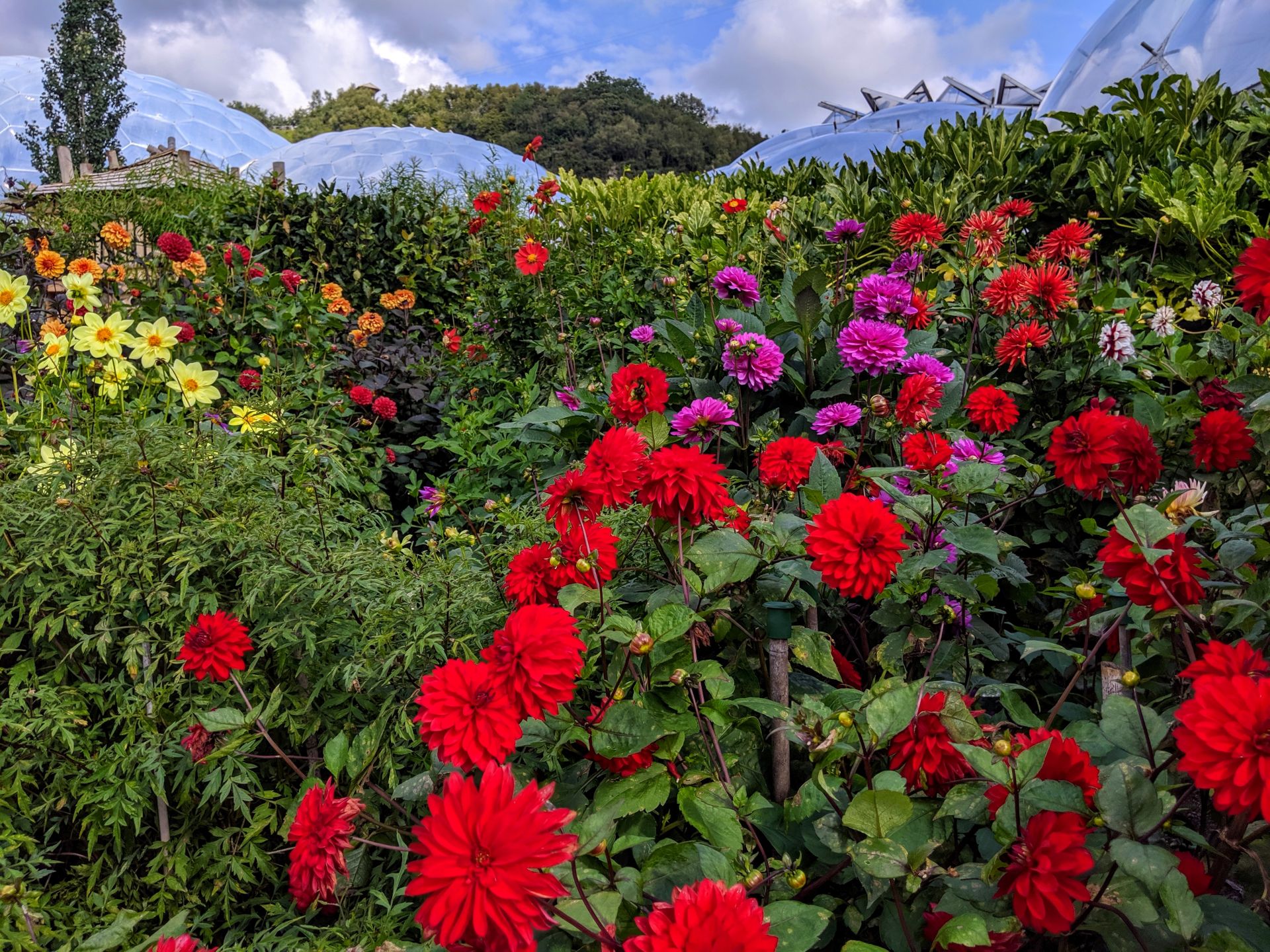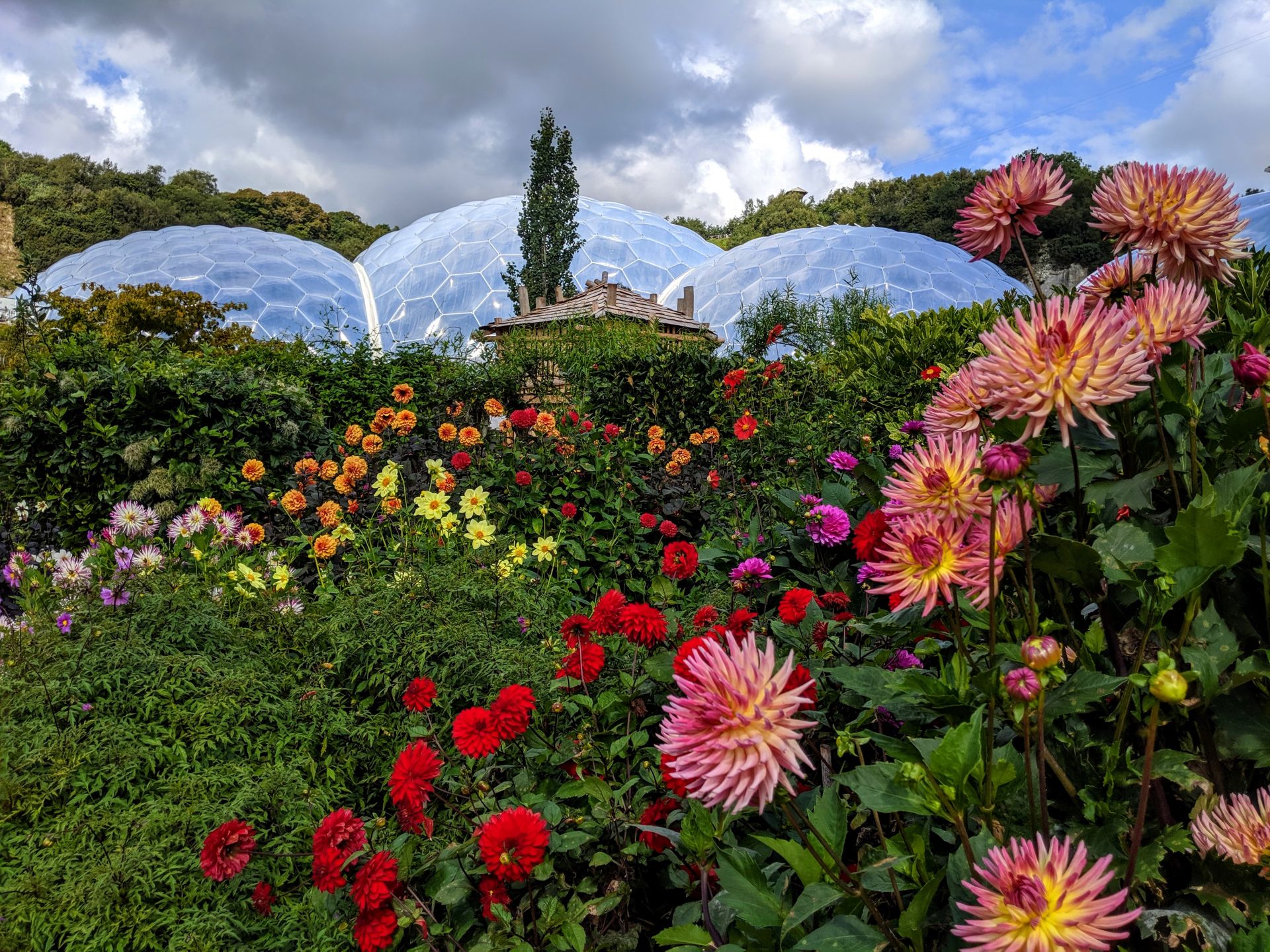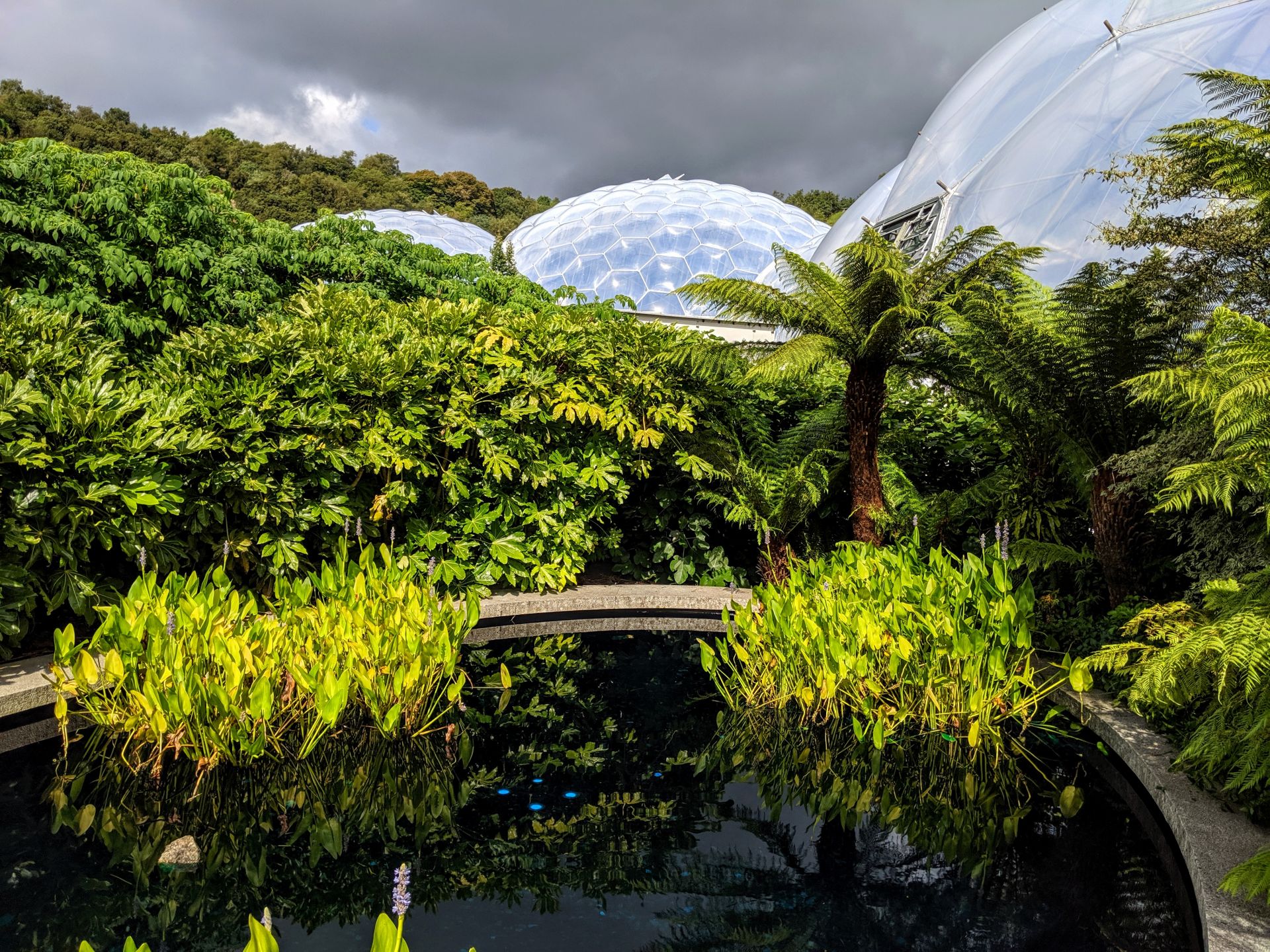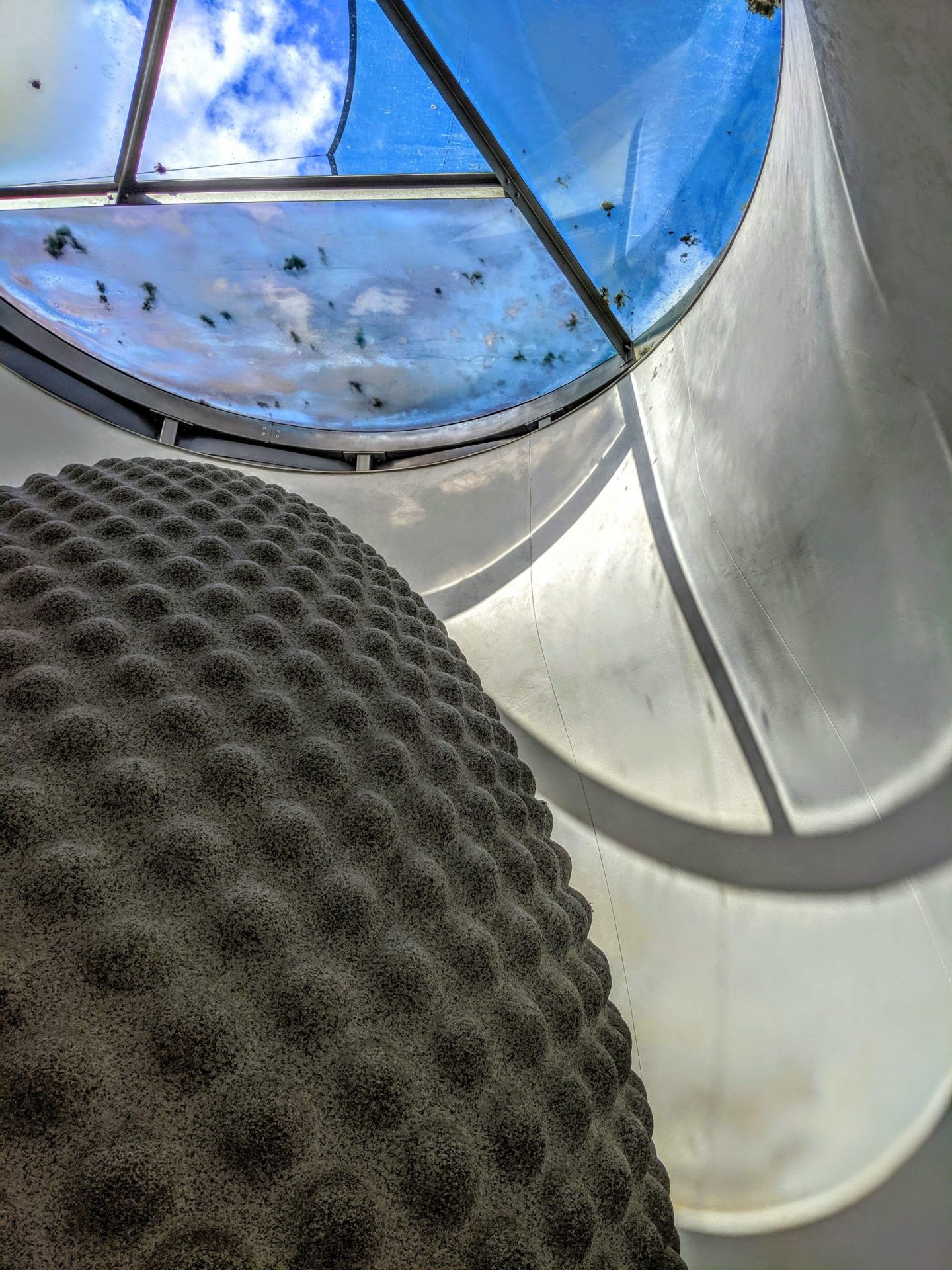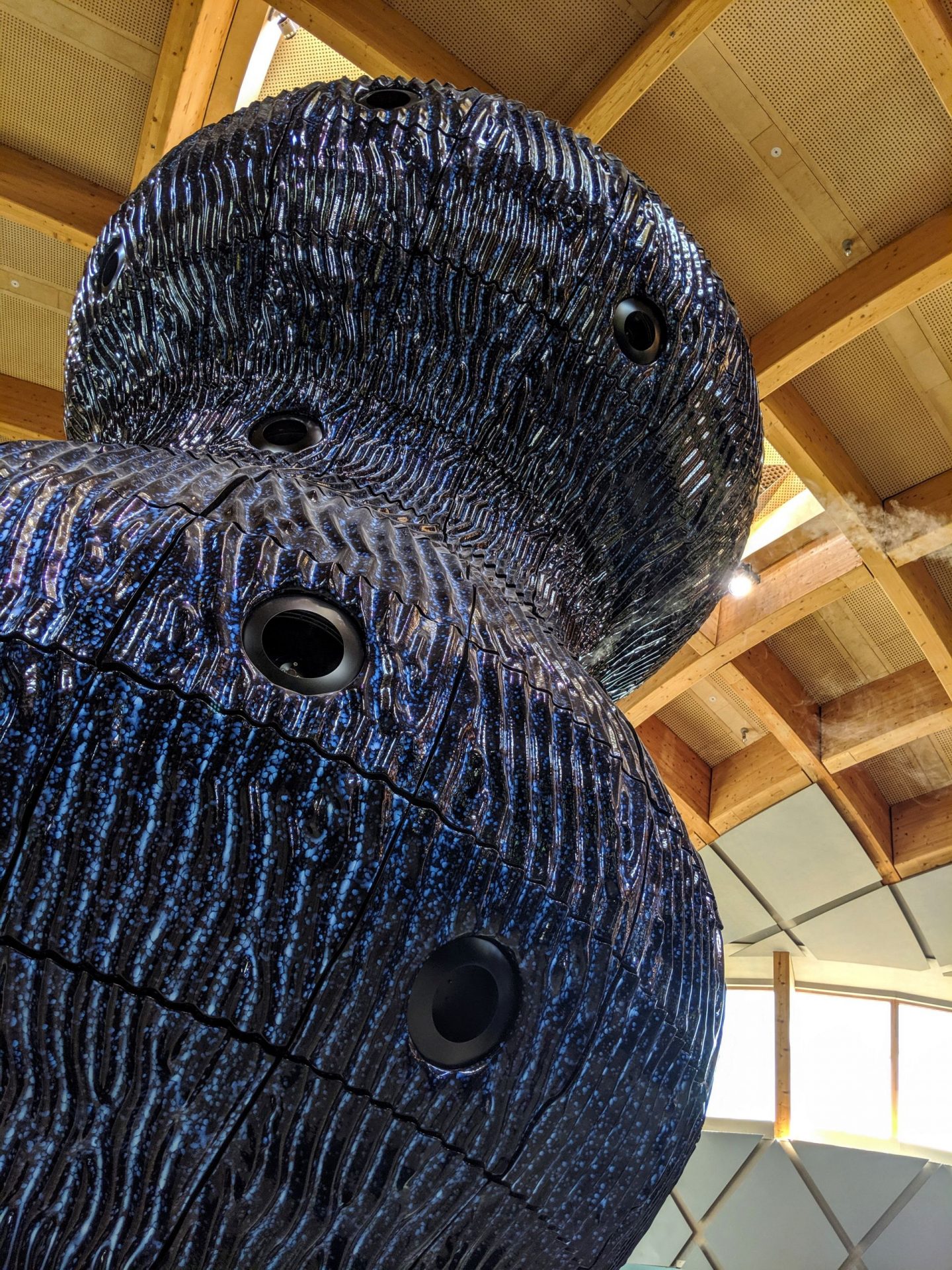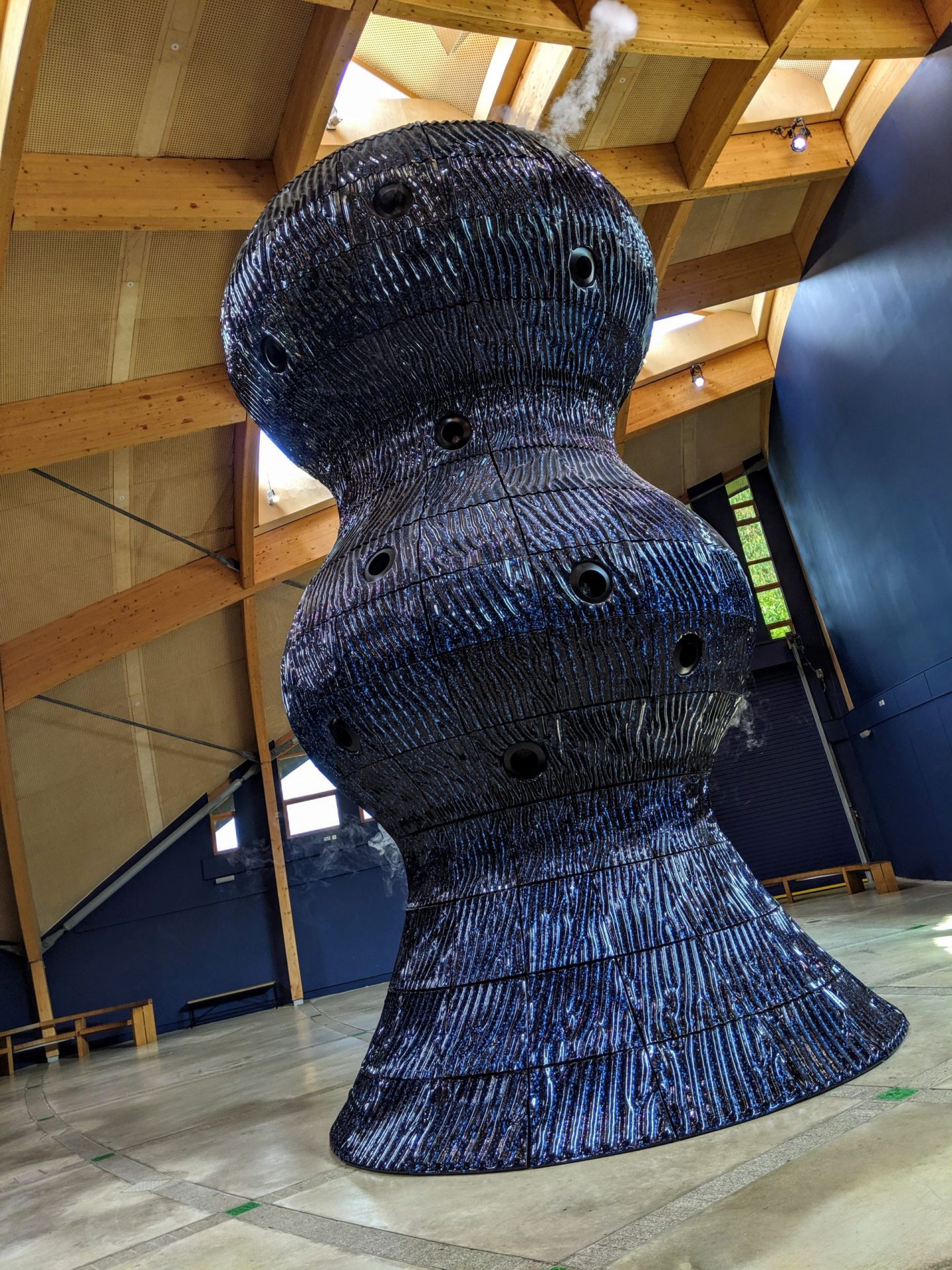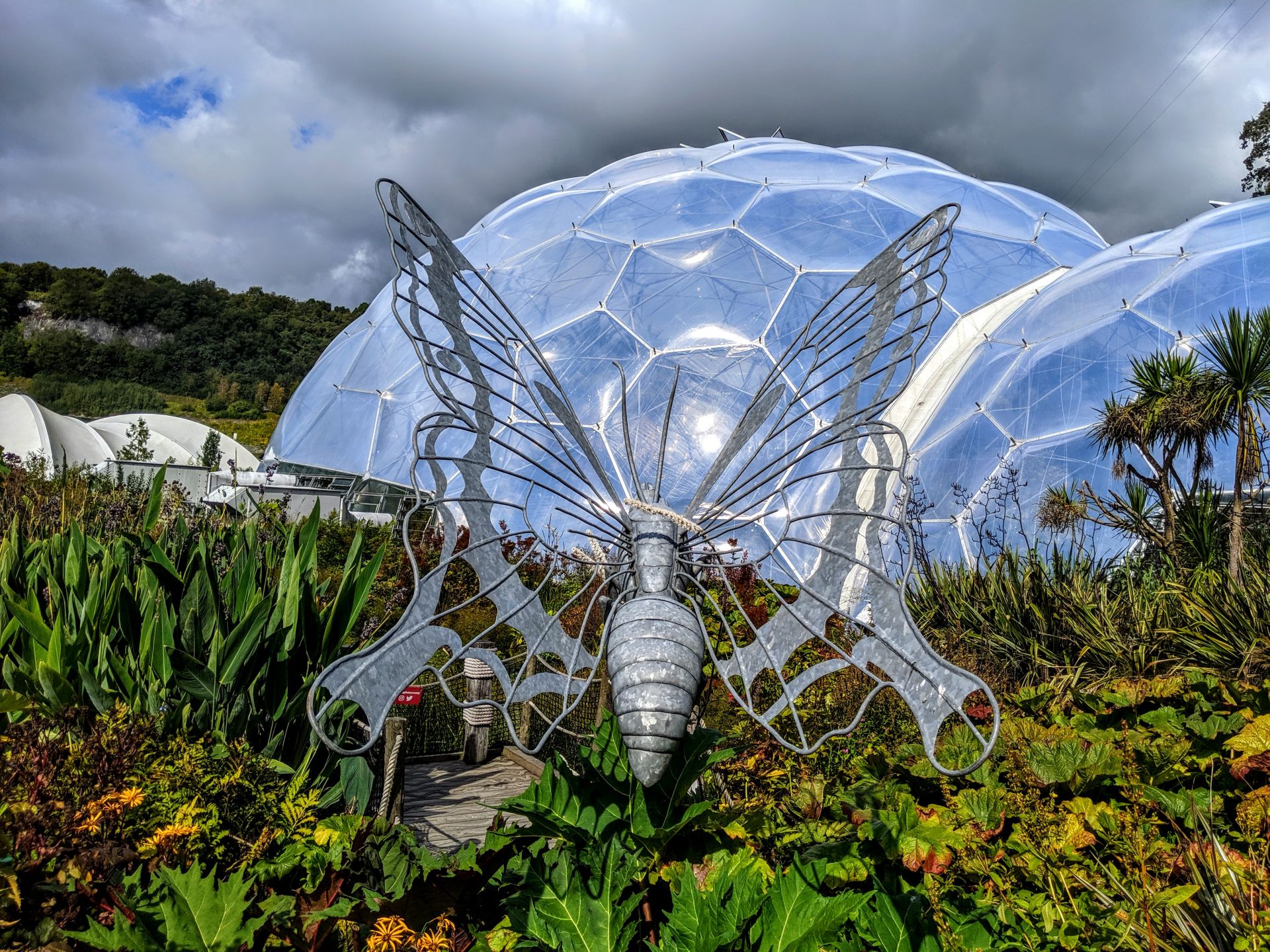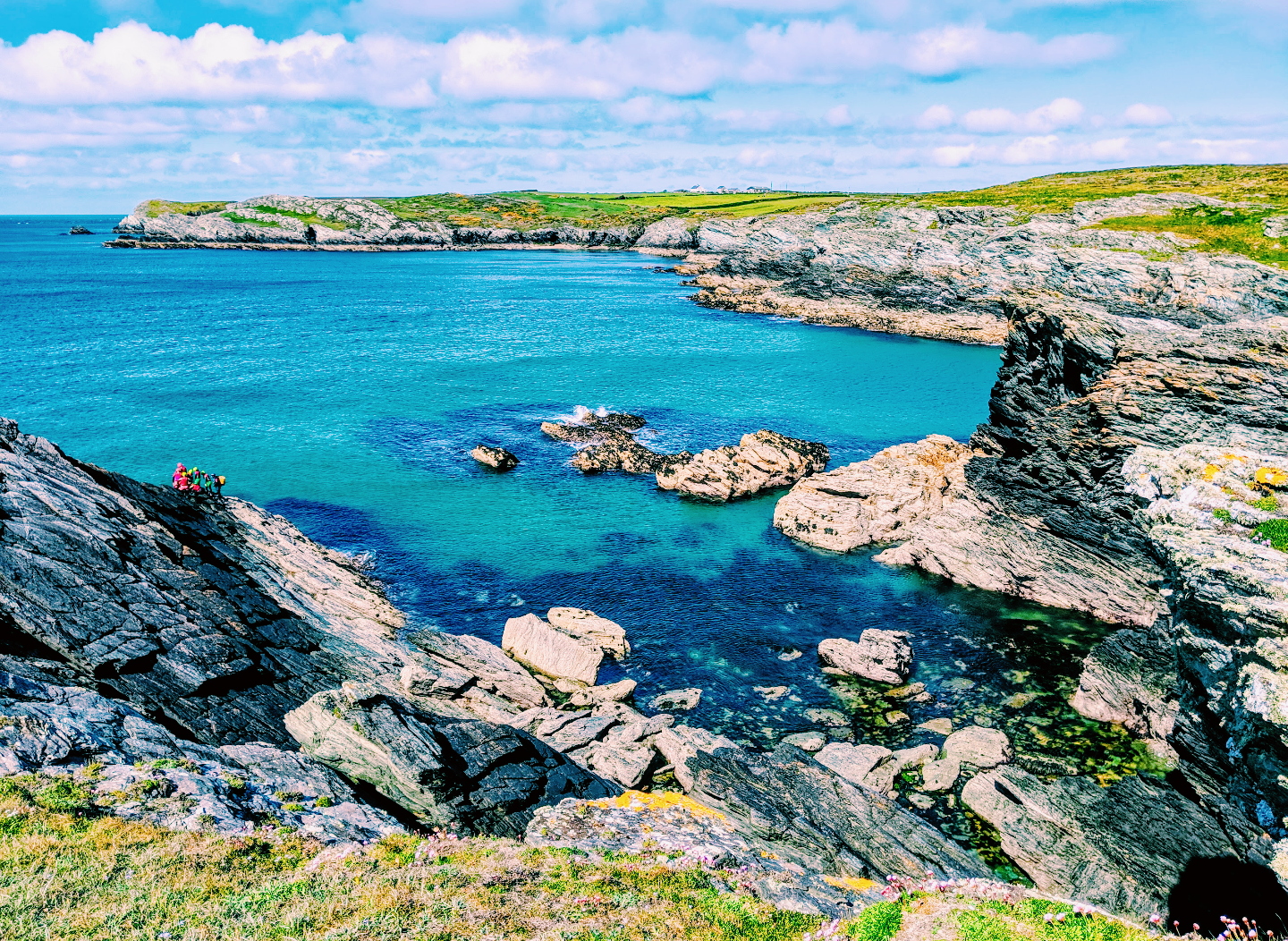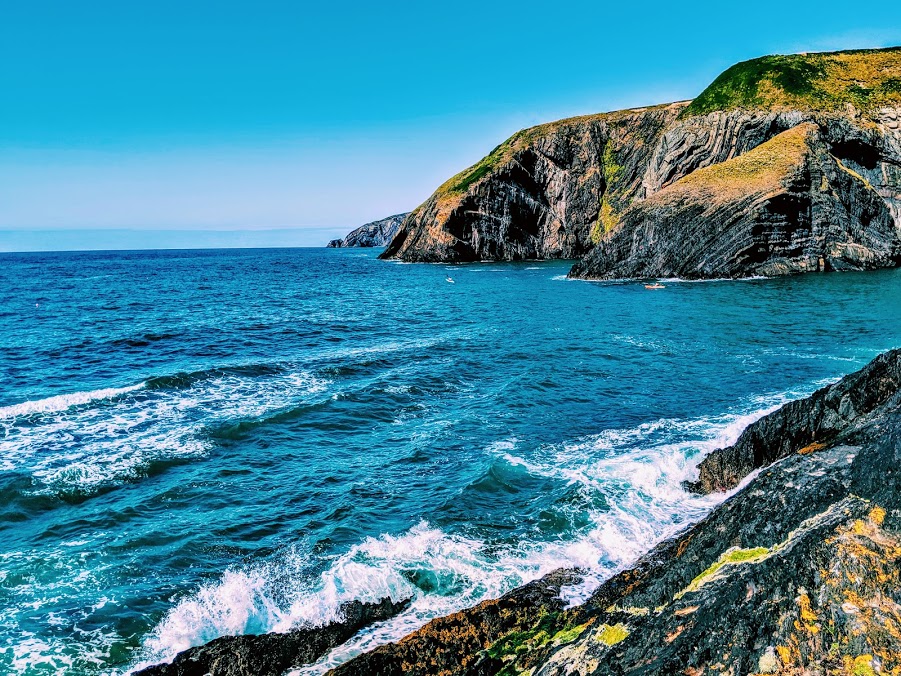“Every flower is a soul blossoming in nature.” – Gerard De Nerval
Eden project has been on my bucket list pretty much since it opened, now I don’t know if I have bigged it up in my head or after spending a week in Cornwall and seeing the environmental issues that the local area faces I didn’t love Eden Project! I mean its beautiful but it felt a bit like the Disney world of plants! I would have loved to see a building/information about local plants, coastal erosion or something about the local area. However I did love the art! And after spending six days pretty much alone heading to a crowd of people wasn’t as fun as it sounds!
The Eden Project was conceived in 1994 by Tim Smit, who was also responsible for recovering the famous Lost Gardens of Heligan The site chosen for the Eden Project was a former china clay pit; a huge crater, 60 metres deep, south facing and sheltered, but with no soil and prone to flooding. In October 1998 building work got under way but was halted in December after weeks of incessant rain. The project opened to the public on 17th March 2001 and by June 2001 the millionth visitor had passed through the gates. You cannot visit the Eden Project without being amazed at the sheer magnitude of it all.
The biome structures are the biggest conservatories in the world, split into a ‘humid tropics biome’ and a ‘warm temperate Mediterranean biome’. A world record 230 miles of free-standing scaffolding poles were used at the construction stage of the humid tropics biome. It contains more than a thousand plant species, mist sprays and dramatic waterfalls. The bubbles are made of inflated hexagonal transparent ‘plastic’ windows with a life-span of more than 25 years, each hexagon being tough enough to take the weight of a rugby team. The structure is made of galvanized steel tubing bolted together and anchored into the foundations.

Bombus the Giant Bee is a beautiful piece of art created by Robert Bradford. Here our Giant Bee looks across to the Biomes, based on honeycombs. Nature’s architecture. Hexagons provide maximum strength using minimum materials. Bombus the Giant Bee focuses upon the central significance of pollination in the ecology of plant life: the mutual dependency between plants and their insect pollinators.

First stop of the day was the Mediterranean Biome which consisted of landscapes of the Mediterranean, South Africa, California and Western Australia. My first shock was it wasn’t as warm as I thought it would be I had to put a bloody cardigan on. But it was beautiful, I would have liked a little more information around but I loved sticking my nose into everything.
Mediterranean facts and figures
- A ‘Mediterranean climate’ means hot, dry summers and frost-free, rainy winters. Winter and spring are the main growing seasons.
- The Mediterranean shares its climate with 4 other regions around the world; South Africa, South West Australia, Central Chile, and California.
- Each region is known for its superb fruits, fine wines and good crops.
- Plants native to these areas thrive on drought and poor thin soils. Their survival techniques include having small, grey, hairy leaves, spiny, evergreen or waxy leaves, and making protective oils.
The first area you walk into is the Mediterranean garden and what I remember Italy to look like. The rugged Mediterranean landscape has been shaped by man over many thousands of years, cleared for crops such as olives and vines. Today, ancient terraced olive groves actually support more animal species than a pine forest, including insects, reptiles, birds, bats and the like. Over the years, many left this land for work on the coast. Some are now returning. Supporting local people through farm holidays and buying their local produce can help look after these environments and communities.
My favourite space was the citrus grove you’ll find oranges, grapefruits, lemons, citrons and even the Buddha’s hand, a fruit segmented into finger-like sections. It was so fragrant the air was sweet with the smell of oranges, I could have sat under the trees for the rest of the day!
Aloe plants are a bloody sexy plant! The scientific name refers to the spiky leaves: ferox means fierce in Latin. The gel from leaves is thought to have healing properties and is used in cosmetics, herbal remedies and food supplements. It is used to soothe irritated skin, like its relative Aloe vera. A hard resinous product extracted from this plant, known as Cape aloes or aloe lump, is used as a laxative (to make people need to go for a poo!) and to treat arthritis.
Western Australia is Australia’s largest and most extraordinary state, where 12,500km of pristine white beaches contrast with the deep red of ancient rock formations and the lush greenery of the stunning southern regions. Western Australia has a special place in my heart and is the area in Australia where I have spent most of my time. The state covers one third of the Australian continent and is a nature lovers’ paradise: over half of the nation’s biodiversity hotspots and a significant percentage of its unique flora and fauna thrive here, and it is home to a wealth of species and animals including the iconic red kangaroos and wallabies.
As well as the citrus grove I adored the sections (forgot what they were called) with tomatoes and Chillies, funny how I loved the food bits the most! I thought I knew most tomato plants, turns out there are a lot I don’t know, also it took a lot of strength not to eat one!
Summer drought, nutrient-poor soils and fire have made the South African plant palette one of the wonders of the world. The country’s Cape Floral Kingdom, a World Heritage Site, is one of the richest areas for plants in the world, boasting over 1,400 plant species that are rare or endangered. The fynbos habitat (fain-boss is Afrikaans for ‘fine bush’) is characterised by evergreen, fire-prone shrubs living on nutrient-poor soil. Formed millions of years ago from the ashes of drought-stressed forests, the fynbos is now managed for conservation with fire, because some of the plants need exposure to fire before they can germinate.
Tim Shaw’s sculptures depict the myth of Dionysus, Greek god of the vines, and his followers, the Maenads, who dance and writhe through the vines beating drums and sounding trumpets. Dionysus is shown as a raging bull, but in ancient Greek myths his wild, untamed nature is often personified as a virile young man, a lion or a serpent. He was later known as Bacchus by the Romans. The story goes that he started out with good intentions as the god of vegetation, but things changed when he went from growing the vine to drinking its fermented juices! The Dionysian myths are amongst the oldest and most potent stories that link mankind with nature. Not only do they serve as an insight into ancient civilisations, but they also articulate truths of human nature that resonate with veracity to this day – beneath the veneer of everyday society lie dark and powerful forces of unpredictable magnitude. We chose to commission Dionysus so he could sit between the wild and cultivated lands, a reminder of the need for balance, a reminder of how delicate that balance is.
After a good couple of hours reading every little bit of information I could find whilst sticking my nose into everything to see what it smelt like I was ready for food! And in true Disney-que style there are lots of places to choose from! I get in the height of summer the place must be packed and there is food for everyone! I opted for a Mediterranean treat. This restaurant is in the biome and is an actual restaurant whereas the rest of the food options feel a little more fast food based. Food was delicious and surprisingly well priced.
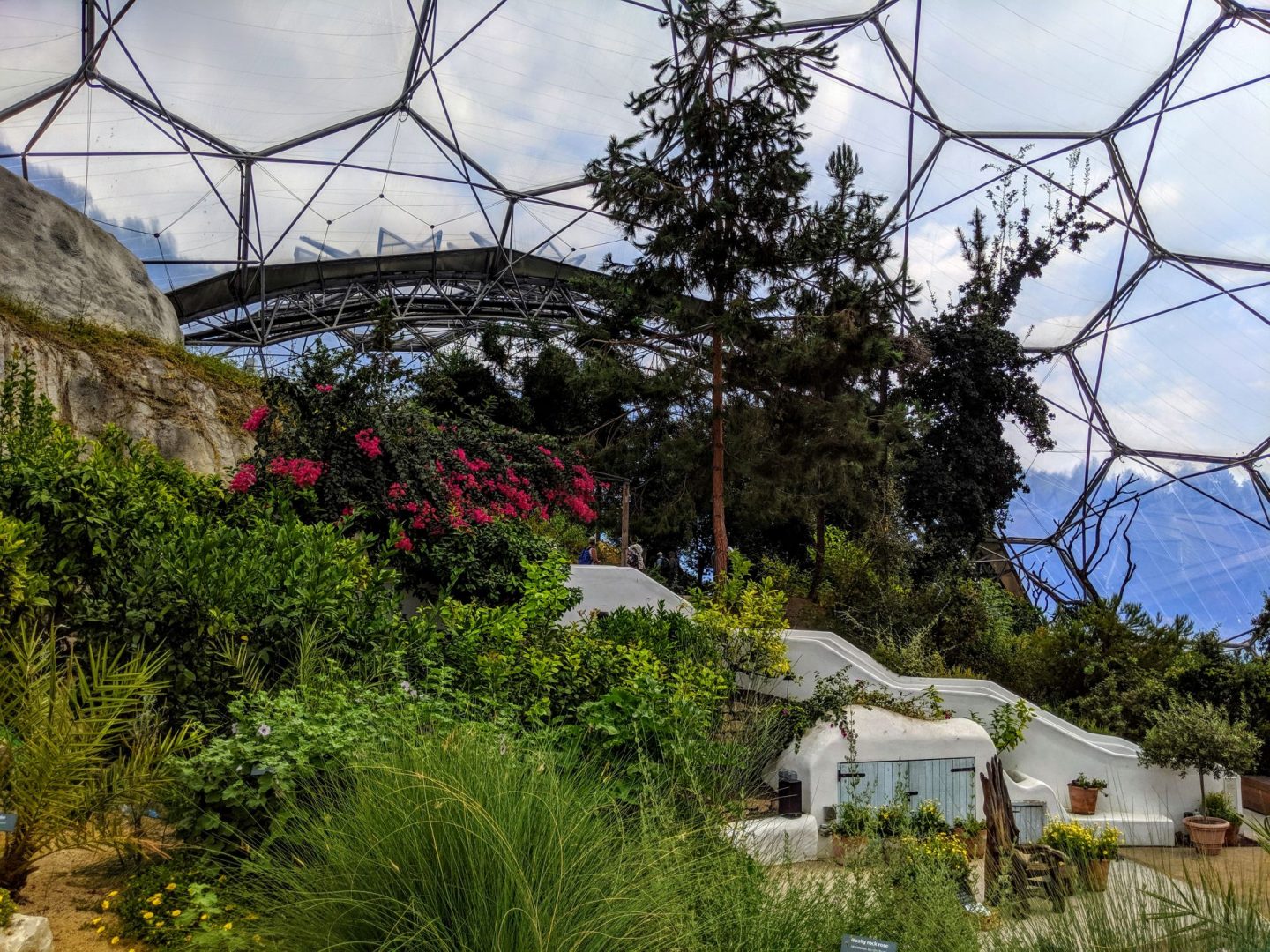
There are a couple of buildings other then the biomes to explore. Invisible Worlds is permanent exhibition that reveals the world beyond our senses. Honestly other than a couple of pieces of beautiful art I didn’t love this building or the exhibition in fact I think I spent a total of twenty minutes here, but its worth a mooch around and maybe you will enjoy it more than me.
“Seed” by Peter Randall-Page is a monumental granite sculpture is constructed from a single piece of Cornish Granite, originally weighing over 167 tonnes, and took almost four years to complete. Its surface is carved with nearly 2,000 ‘nodes’. The spiral pattern on which the sculpture is based bears no relation to a horizontal and vertical grid, which made the task particularly complex, involving as it did a balance between geometric accuracy and organic freedom. The changing weather and seasons play across the sculpture’s undulating, tactile surface.
The huge ceramic ‘breathing’ sculpture pays homage to one of the world’s smallest but most important organisms: the cyanobacteria. Artist duo Studio Swine wanted to build a monument to these vital but invisible unsung heroes. Three billion years ago the cyanobacteria started to produce oxygen – which changed the face of the Earth forever. Today they, and their distant descendants found in plants and phytoplankton, provide the oxygen in every breath we take. Without them we would not be here.
Eventually I wandered back outside into the sunshine and strolled over to the second dome ready to explore the rain forest! I will be posting more tomorrow about Eden Project, since returning I have been reading lots about it and have warmed more to it and the projects its involved with, I will add links into tomorrows post.
